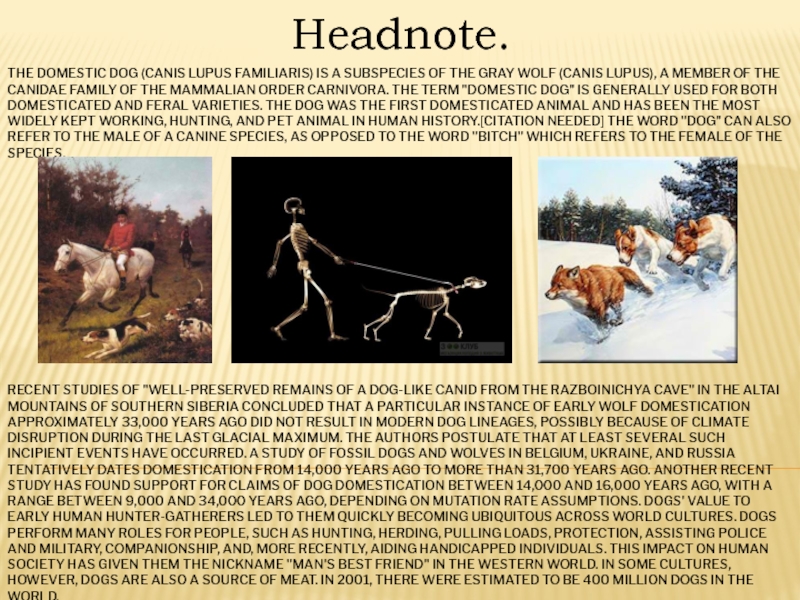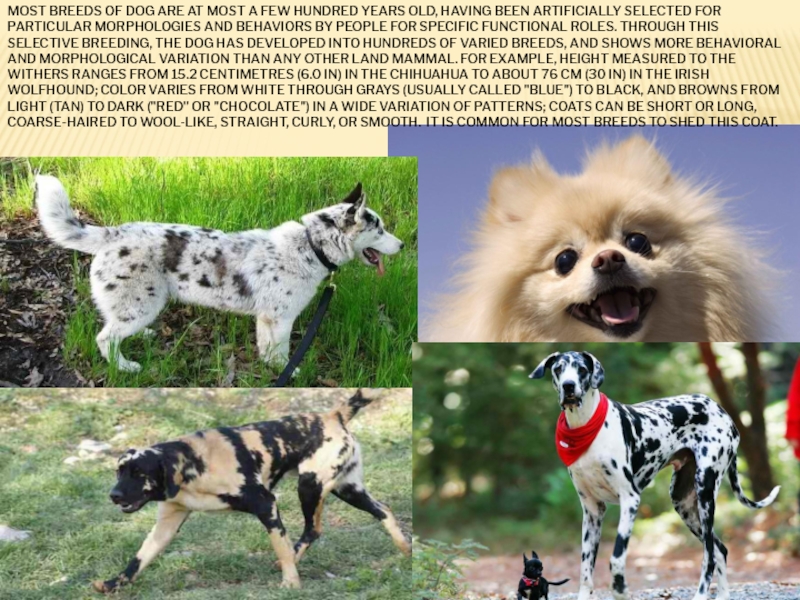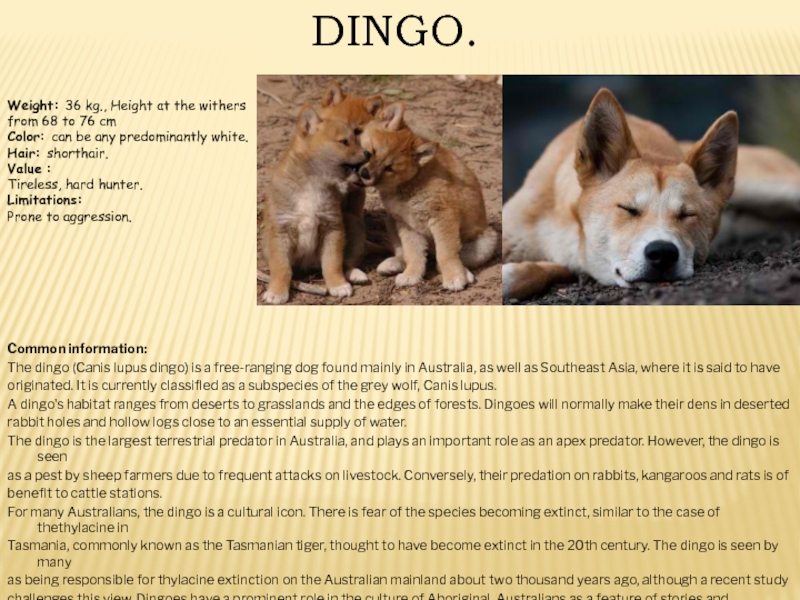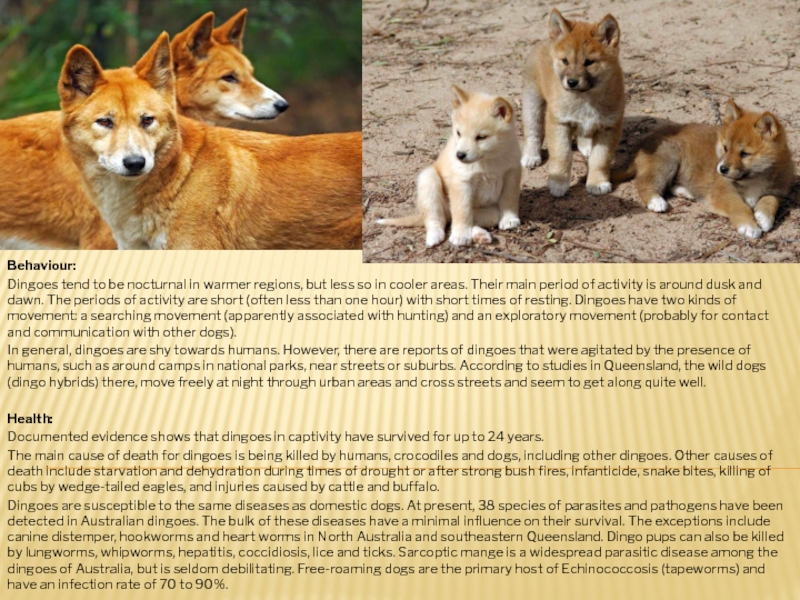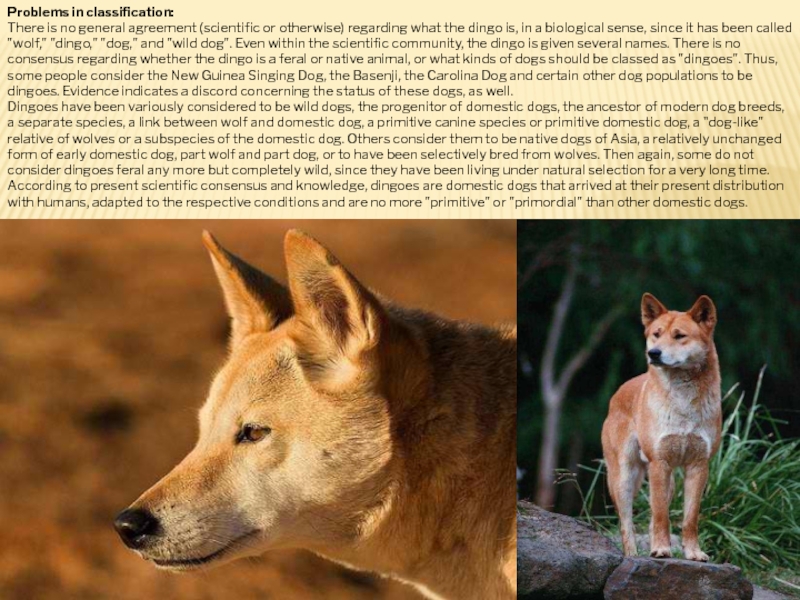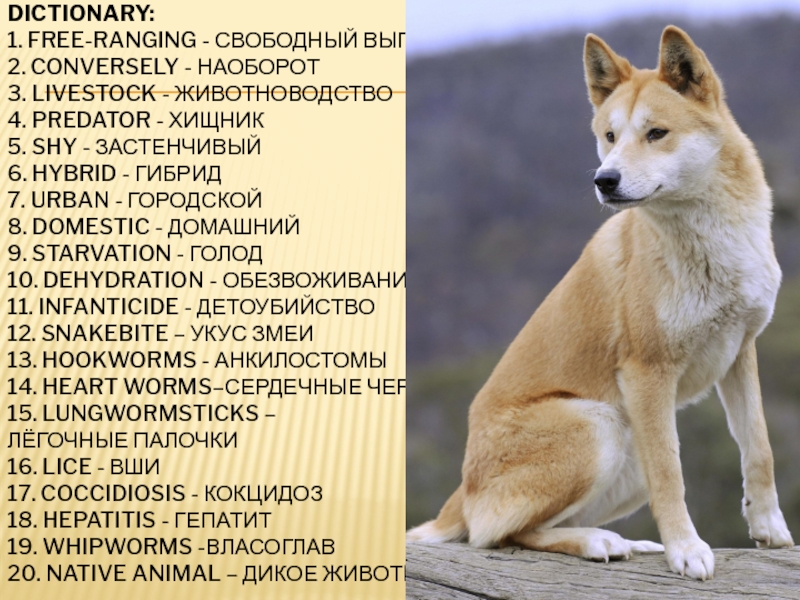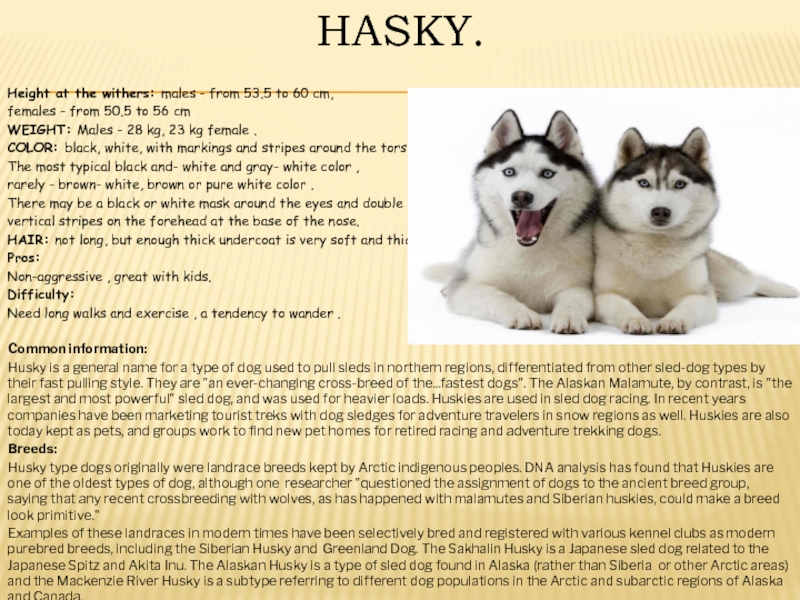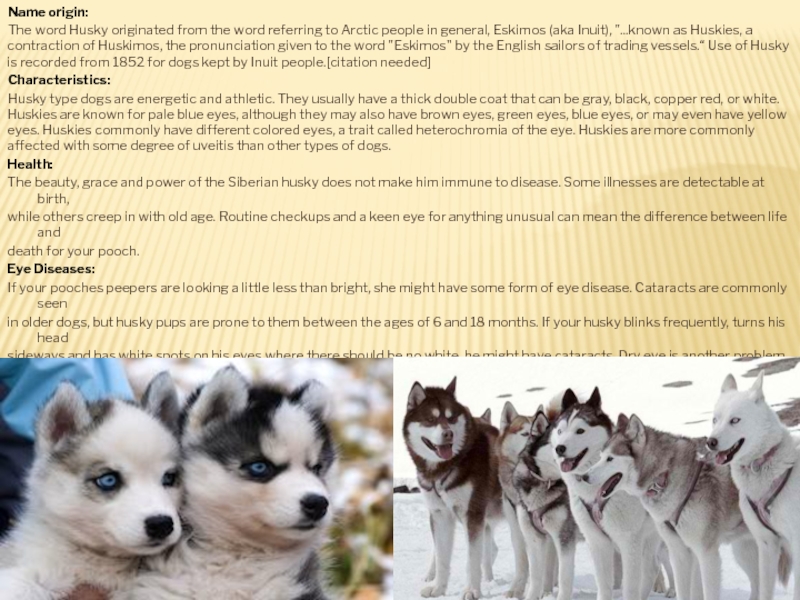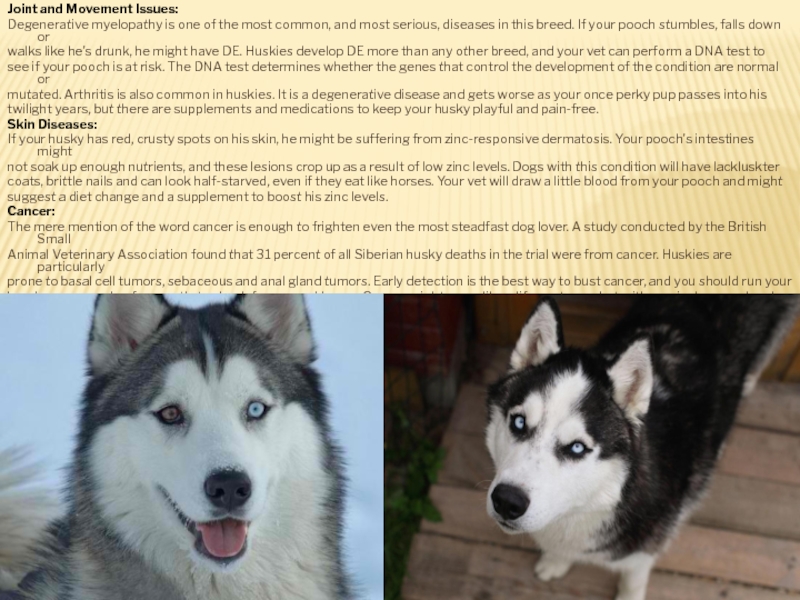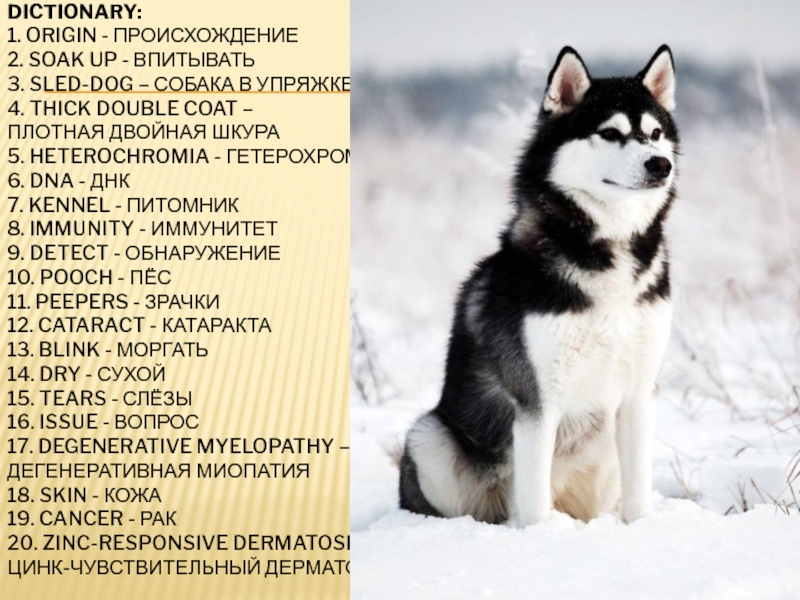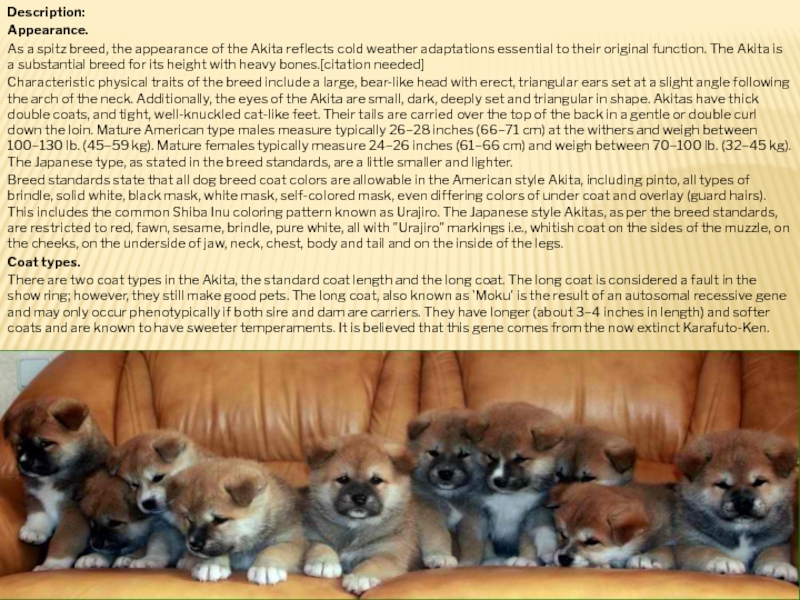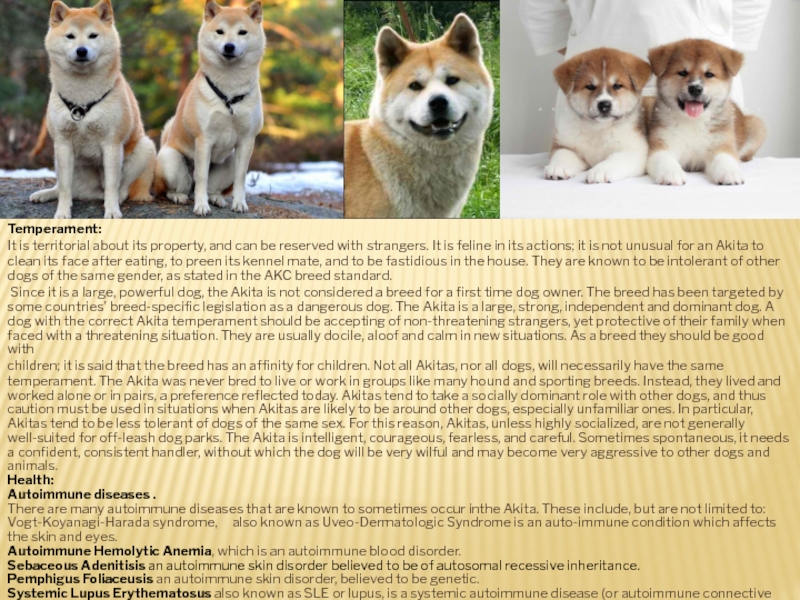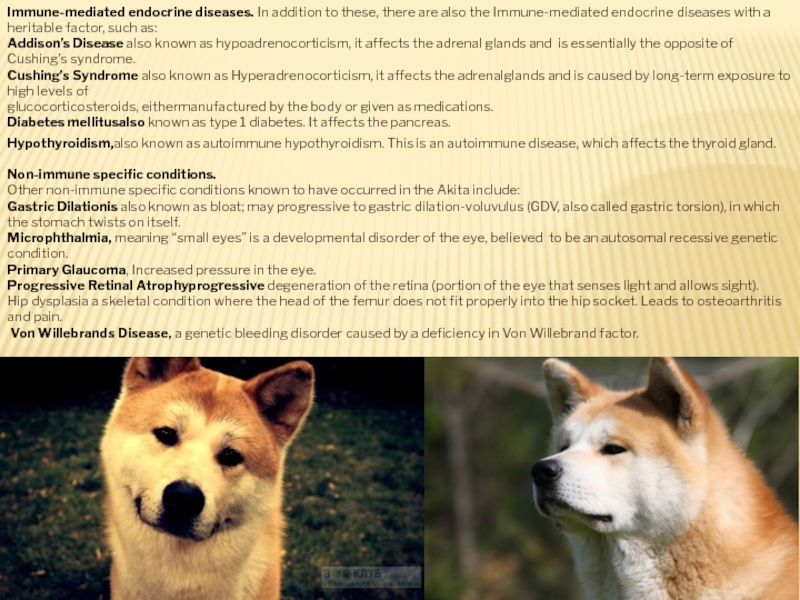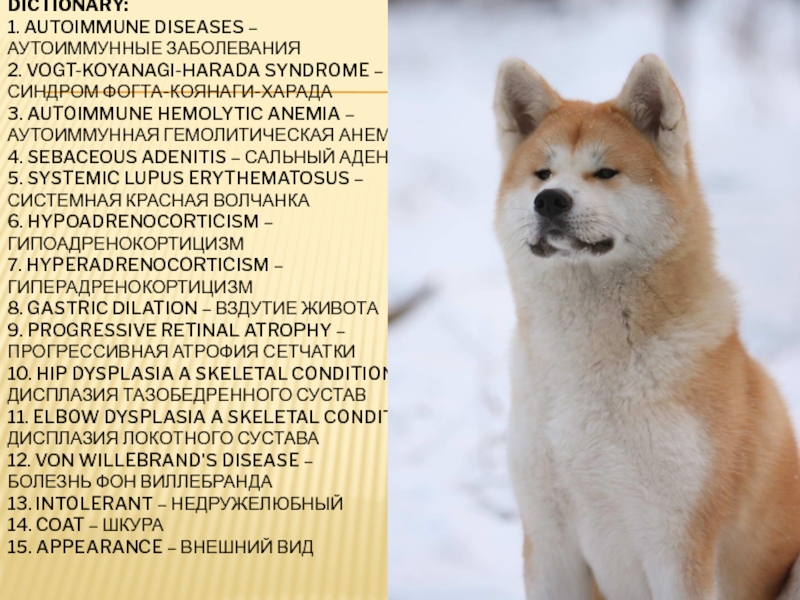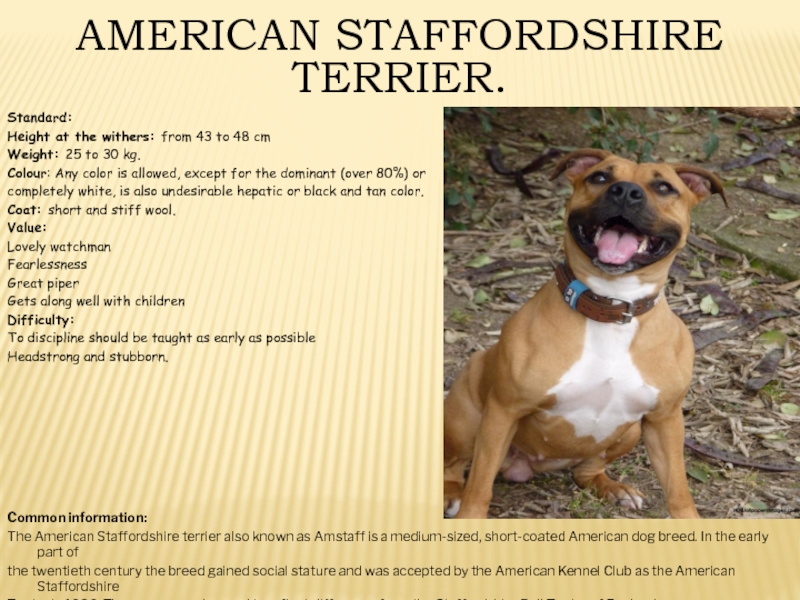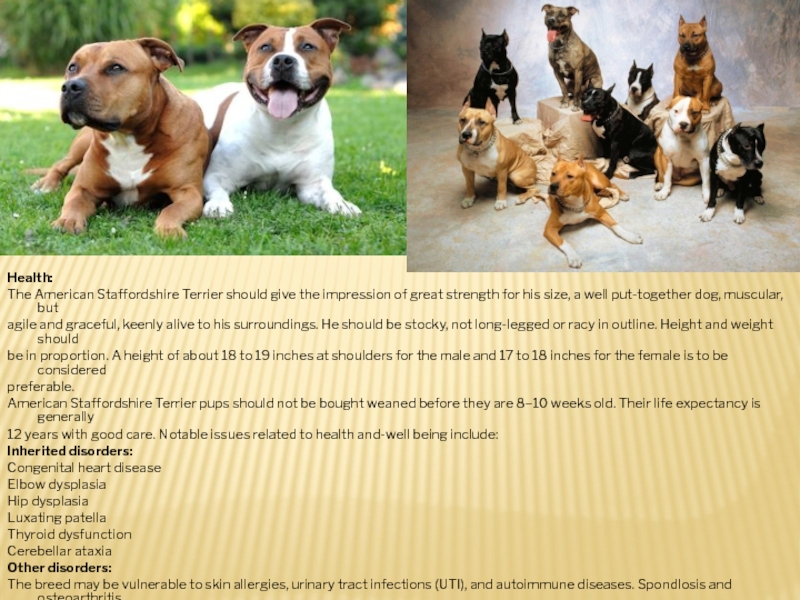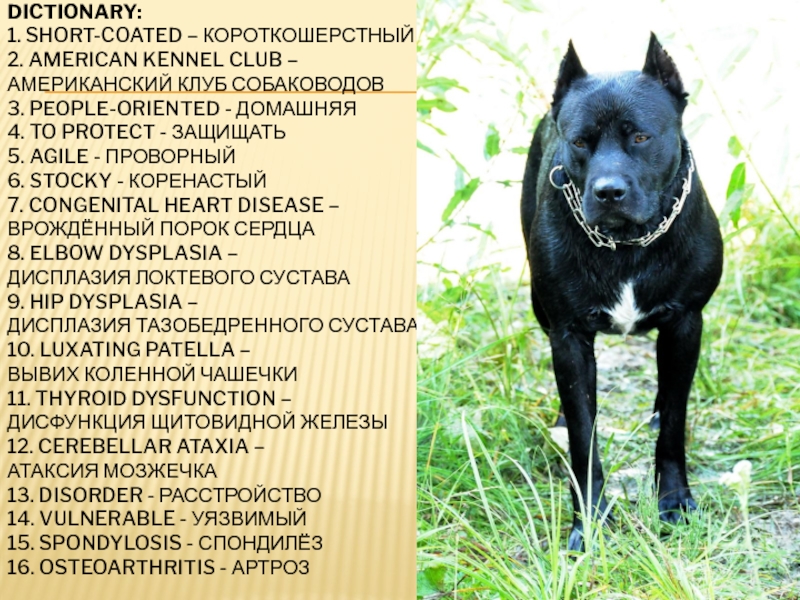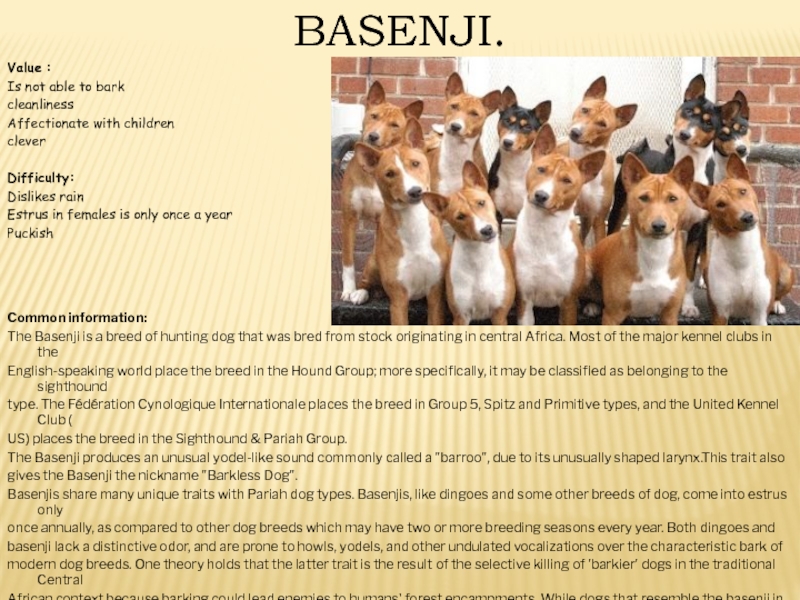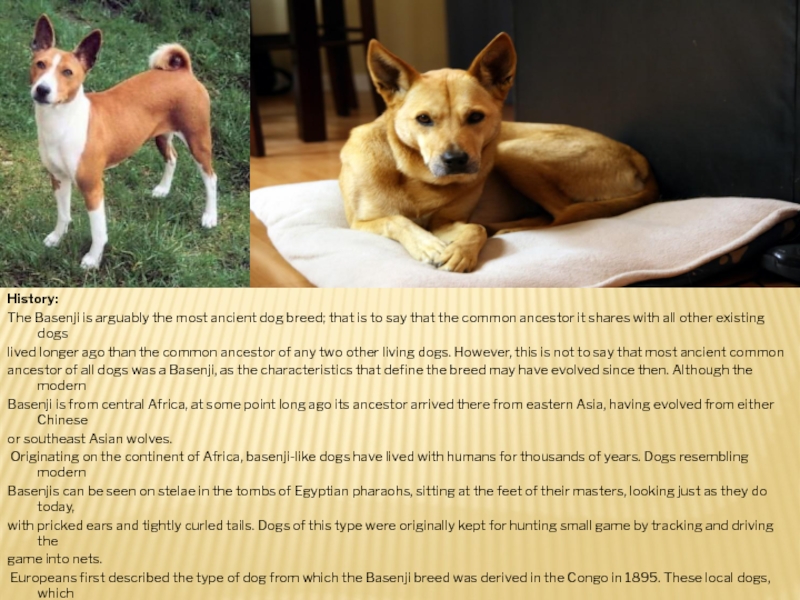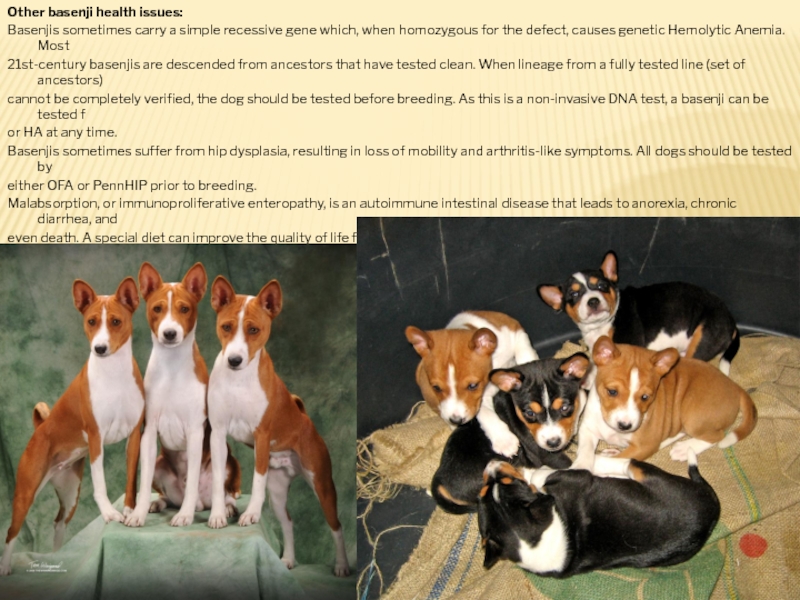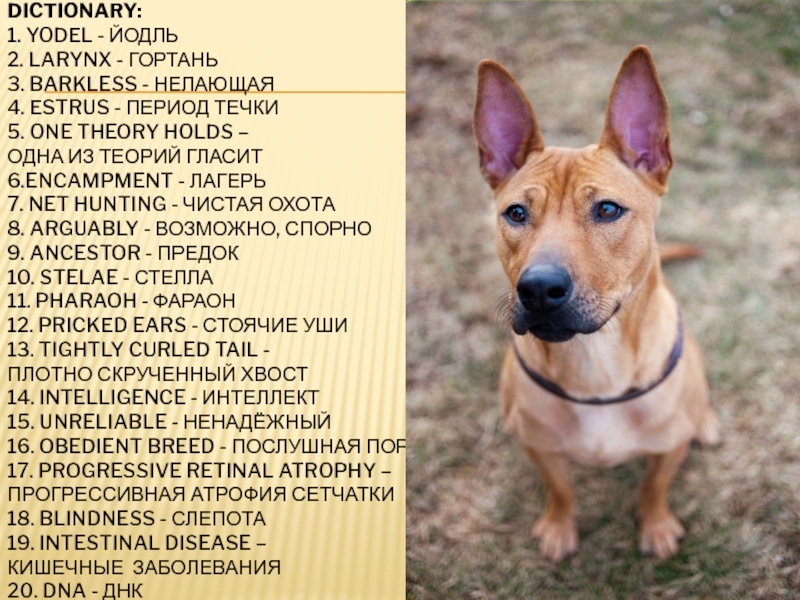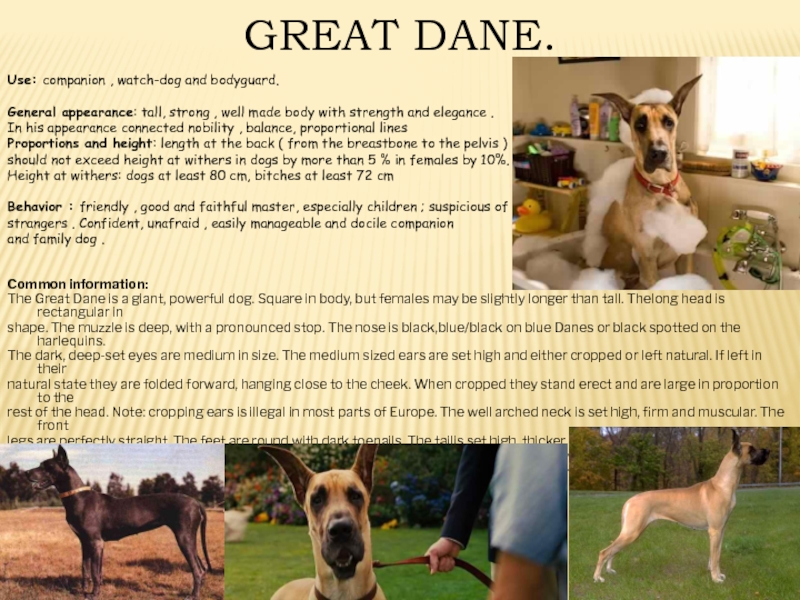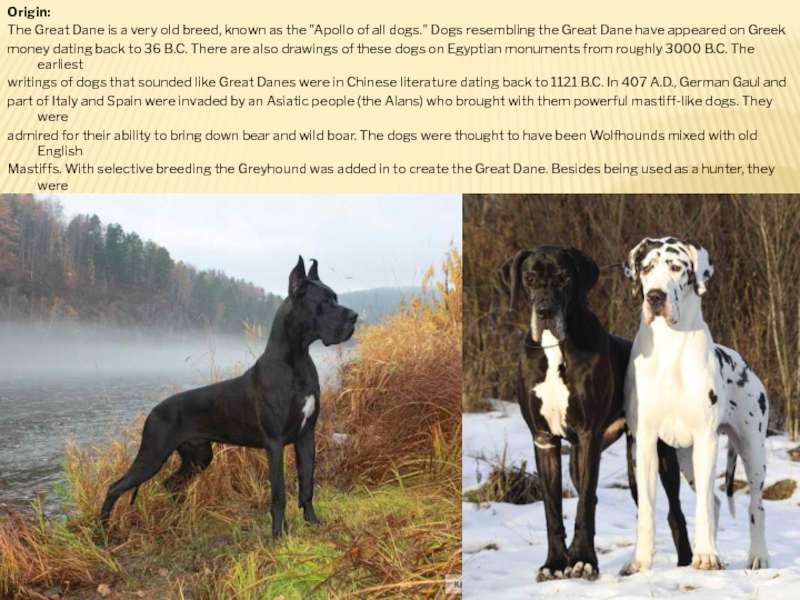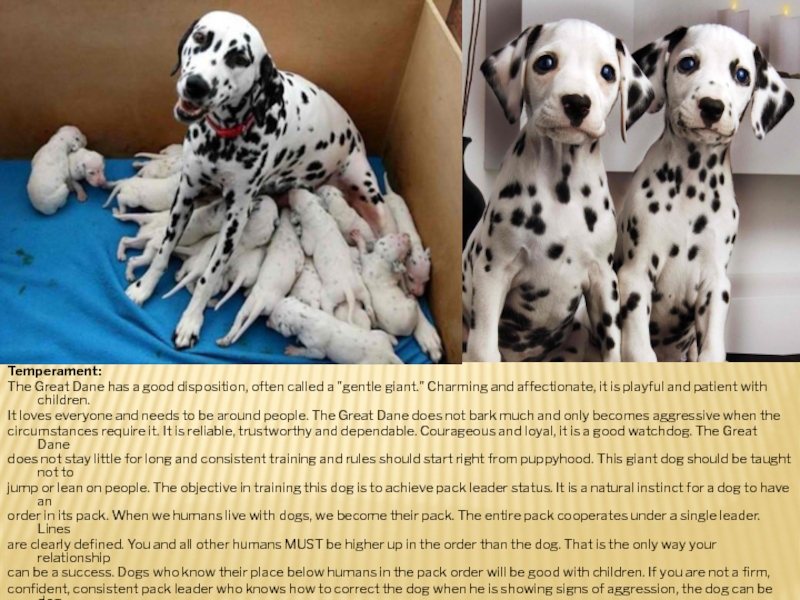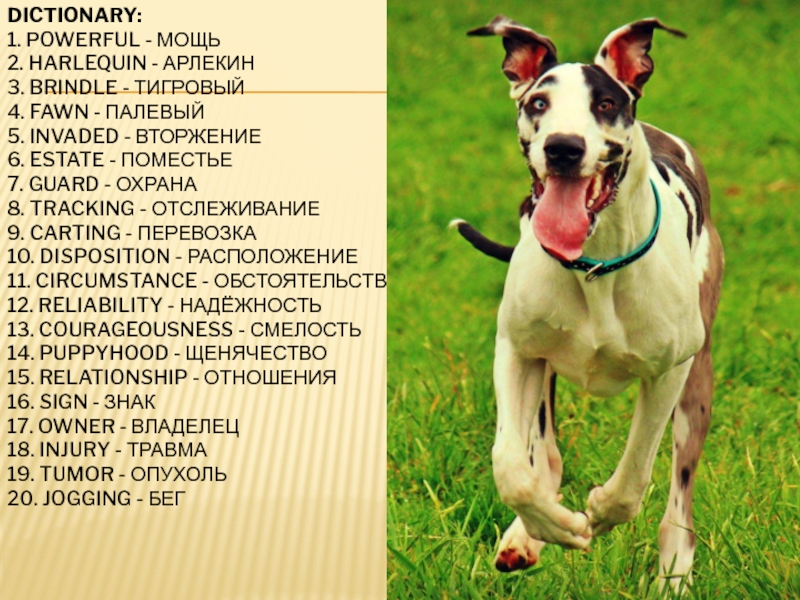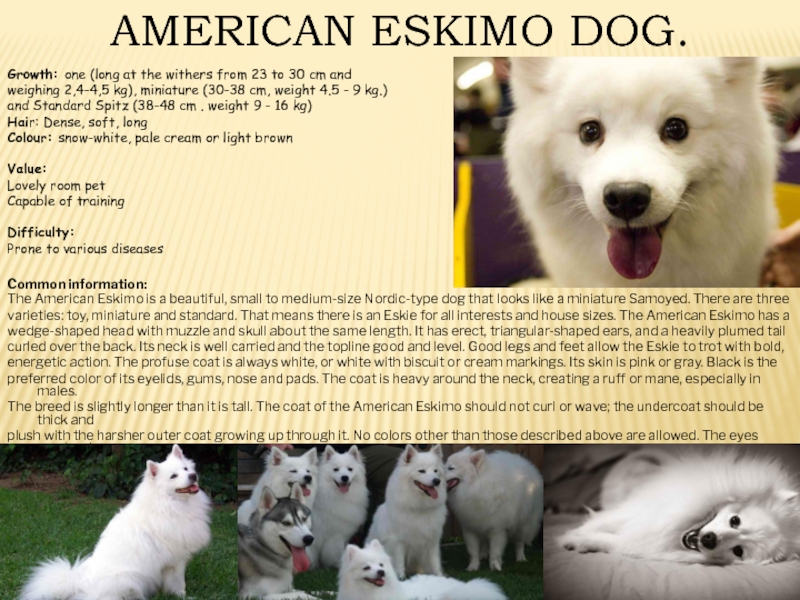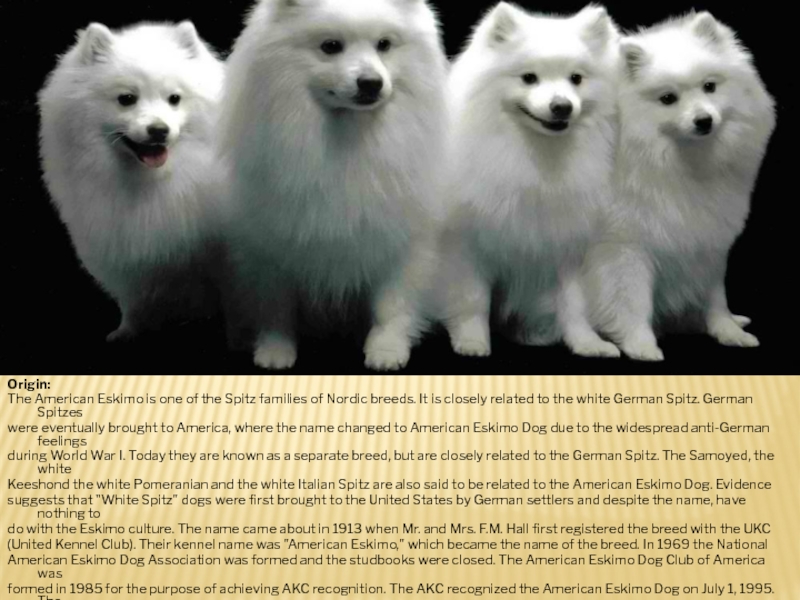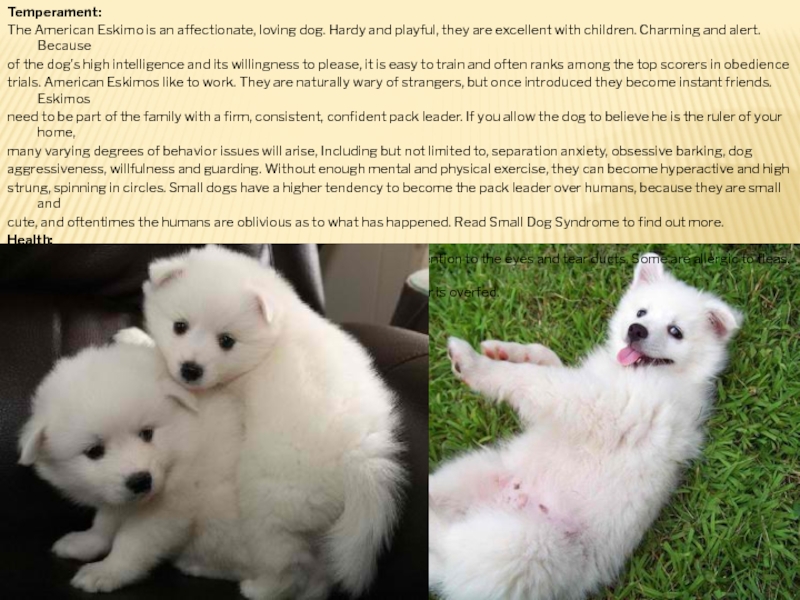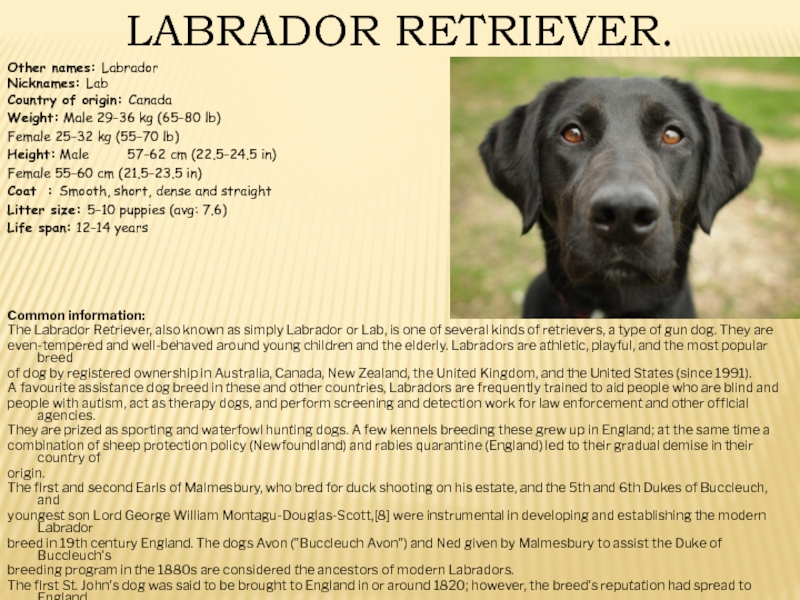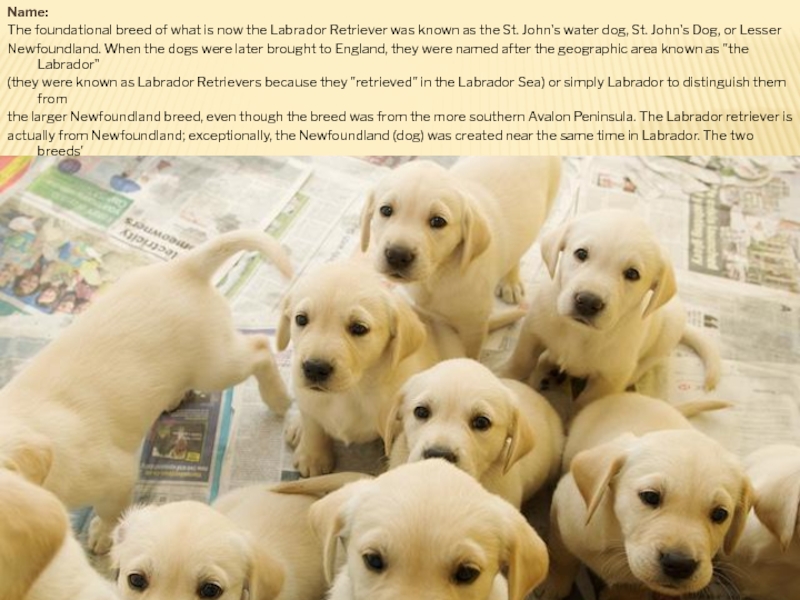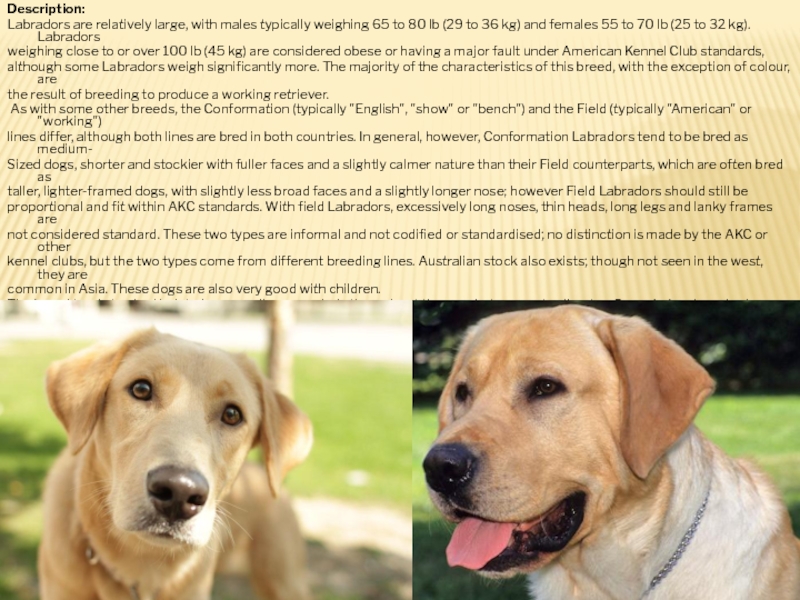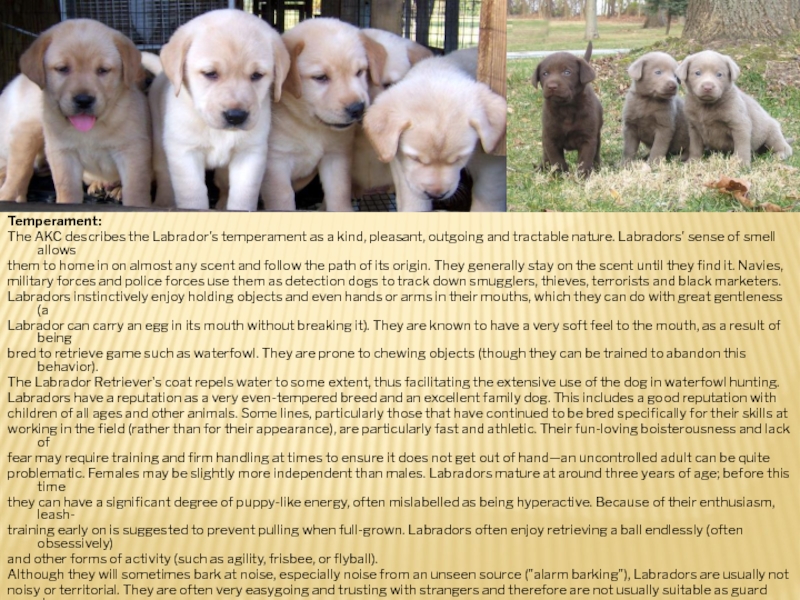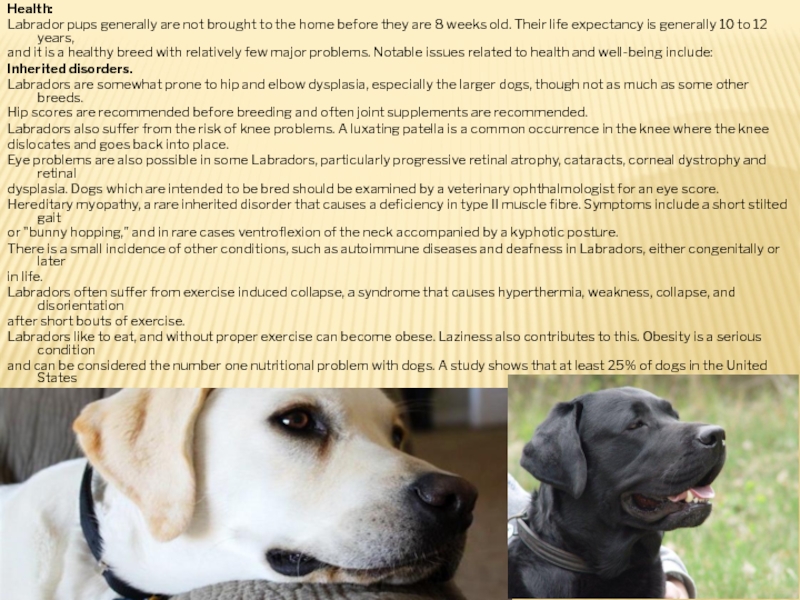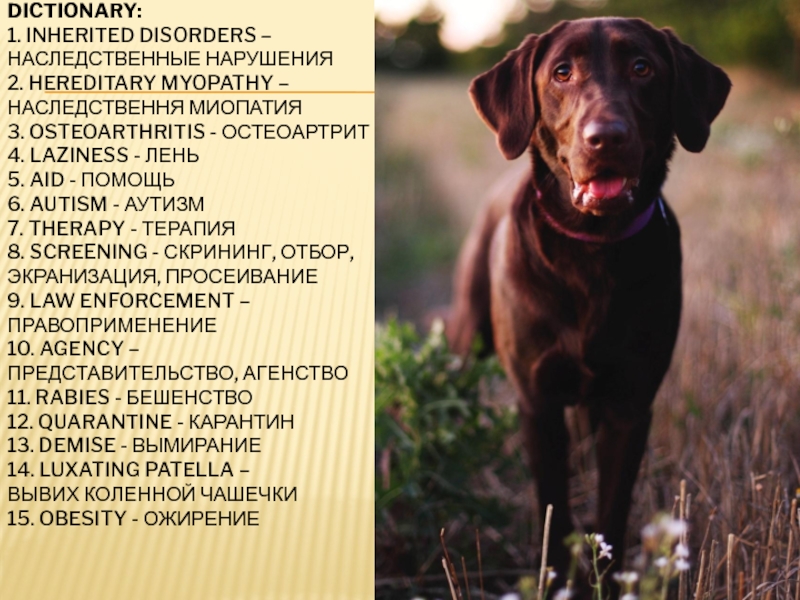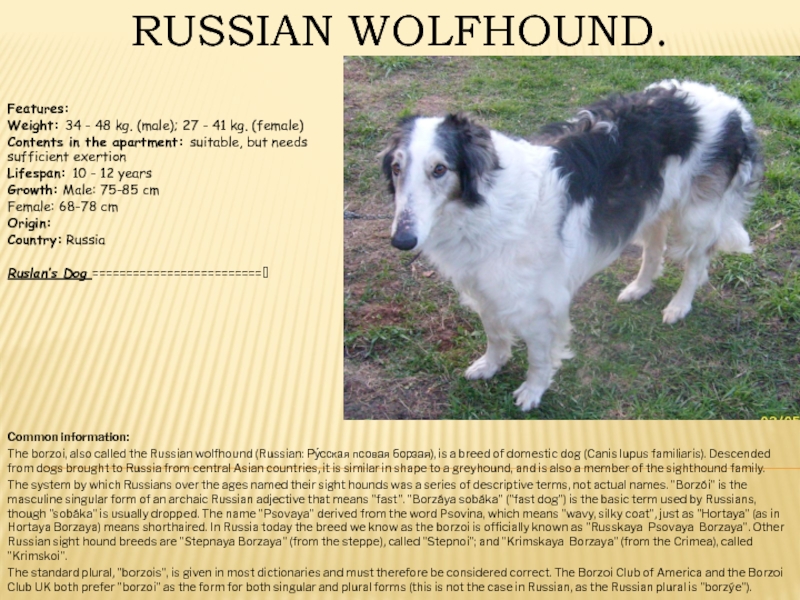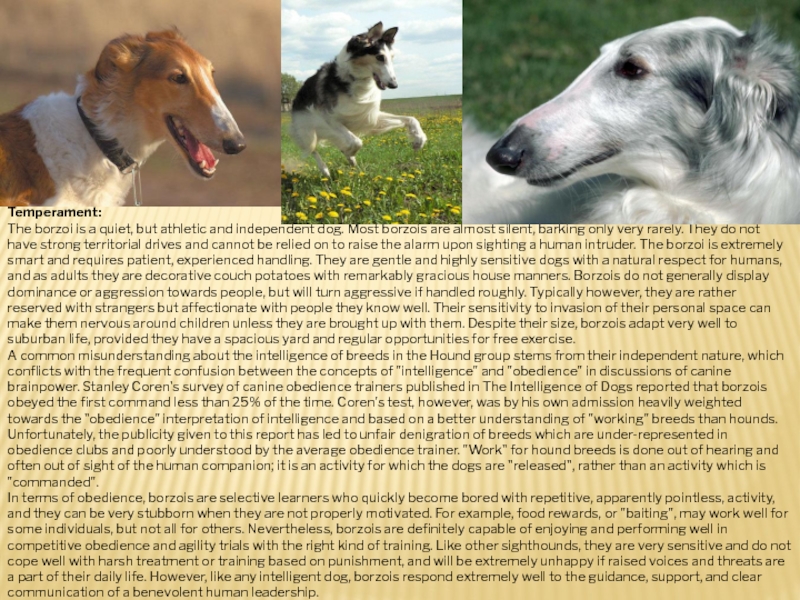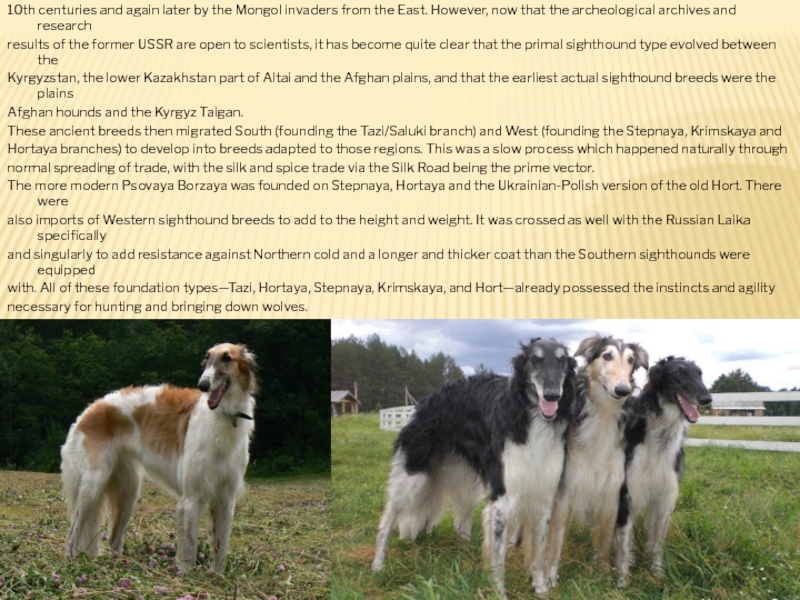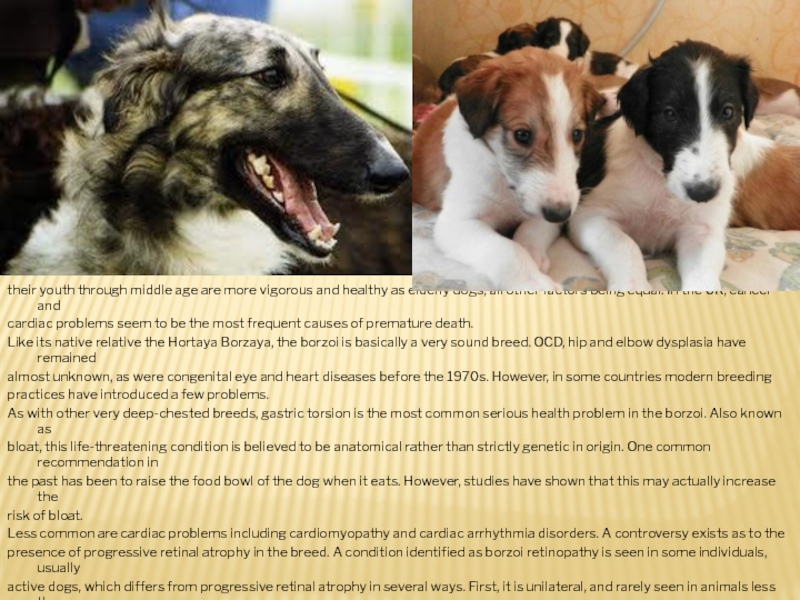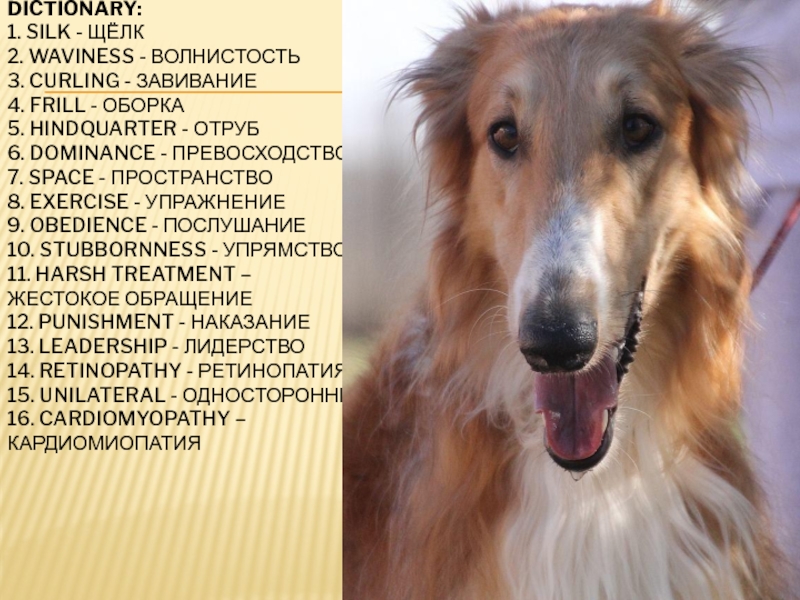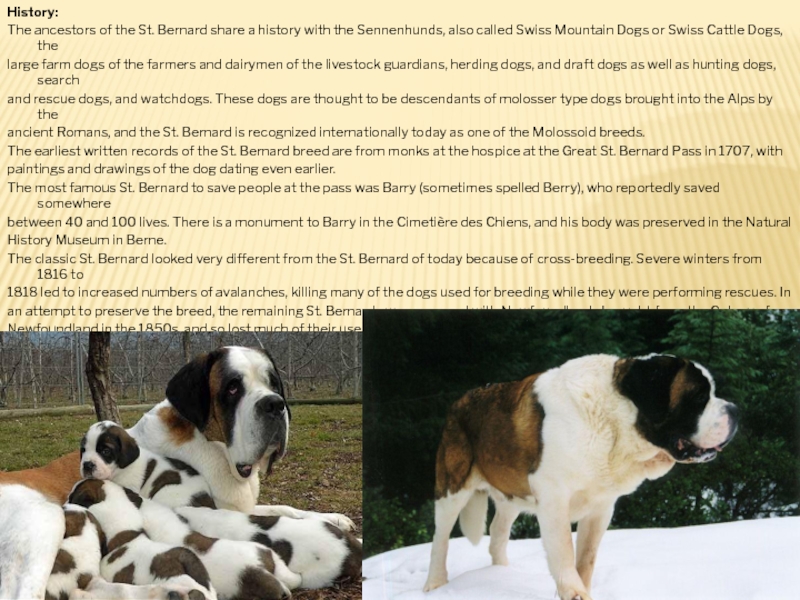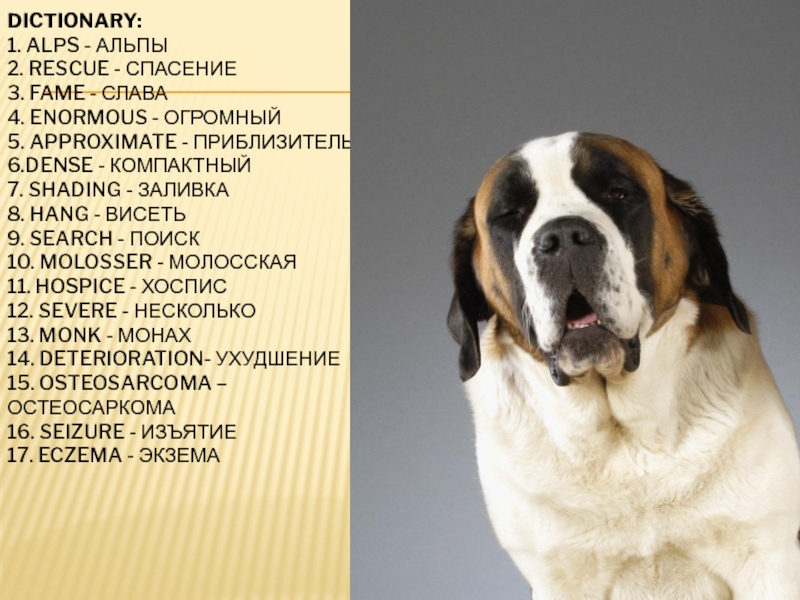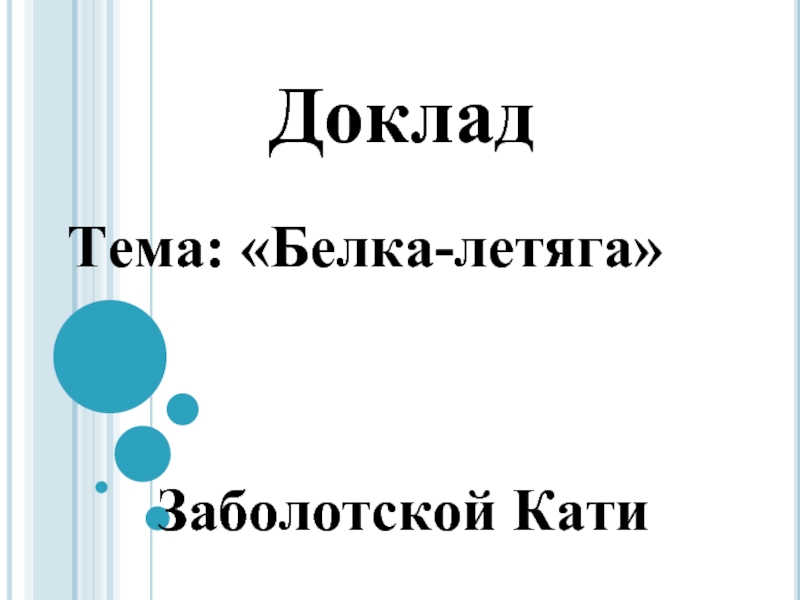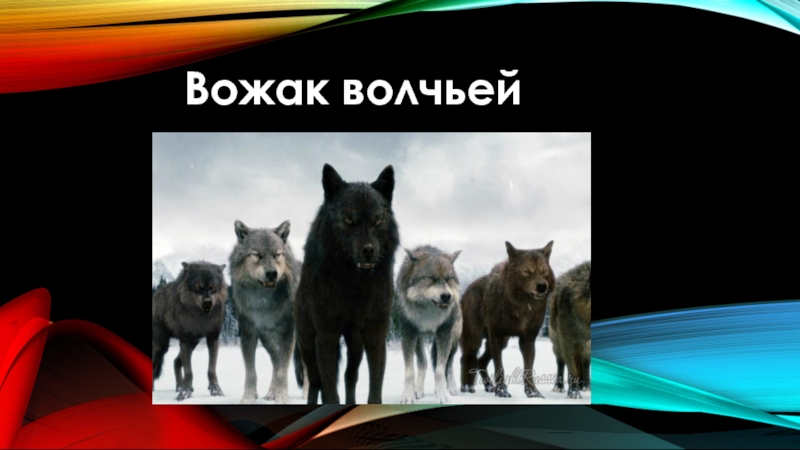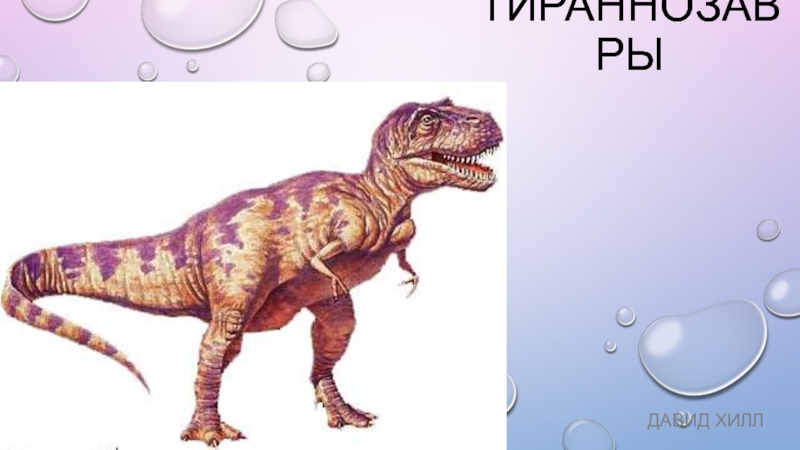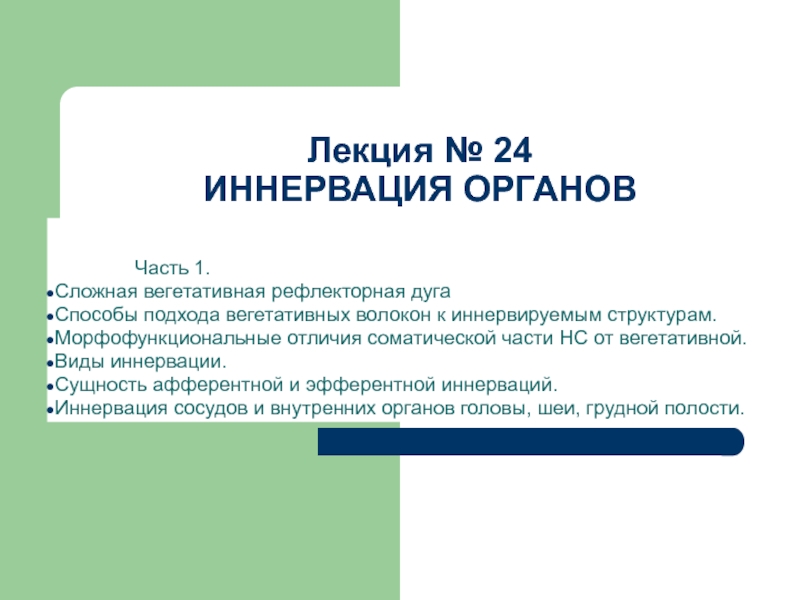- Главная
- Разное
- Дизайн
- Бизнес и предпринимательство
- Аналитика
- Образование
- Развлечения
- Красота и здоровье
- Финансы
- Государство
- Путешествия
- Спорт
- Недвижимость
- Армия
- Графика
- Культурология
- Еда и кулинария
- Лингвистика
- Английский язык
- Астрономия
- Алгебра
- Биология
- География
- Детские презентации
- Информатика
- История
- Литература
- Маркетинг
- Математика
- Медицина
- Менеджмент
- Музыка
- МХК
- Немецкий язык
- ОБЖ
- Обществознание
- Окружающий мир
- Педагогика
- Русский язык
- Технология
- Физика
- Философия
- Химия
- Шаблоны, картинки для презентаций
- Экология
- Экономика
- Юриспруденция
Domestic dog breeds. Particular care, treatment and behavior презентация
Содержание
- 1. Domestic dog breeds. Particular care, treatment and behavior
- 2. THE DOMESTIC DOG (CANIS LUPUS FAMILIARIS) IS
- 3. MOST BREEDS OF DOG ARE AT MOST
- 4. Weight: 36 kg., Height at the withers
- 5. Behaviour: Dingoes tend to be nocturnal in
- 6. Problems in classification: There is no general
- 7. DICTIONARY: 1. FREE-RANGING - СВОБОДНЫЙ ВЫГУЛ
- 8. HASKY. Common information: Husky is a general
- 9. Name origin: The word Husky originated from
- 10. Joint and Movement Issues: Degenerative myelopathy is
- 11. DICTIONARY: 1. ORIGIN - ПРОИСХОЖДЕНИЕ 2. SOAK
- 12. Growth: male :64-69 cm, female: 58-64 cm
- 13. Description: Appearance. As a spitz
- 14. Temperament: It is territorial about its
- 15. Immune-mediated endocrine diseases. In addition to these,
- 16. DICTIONARY: 1. AUTOIMMUNE DISEASES – АУТОИММУННЫЕ
- 17. AMERICAN STAFFORDSHIRE TERRIER. Standard:
- 18. History: Origins: Despite its name, the Staffordshire
- 19. Health: The American Staffordshire Terrier should
- 20. DICTIONARY: 1. SHORT-COATED – КОРОТКОШЕРСТНЫЙ 2. AMERICAN
- 21. BASENJI. Value : Is not able
- 22. History: The Basenji is arguably the most
- 23. Characteristics: Appearance: Basenjis are small, elegant-looking, short-haired
- 24. Other basenji health issues: Basenjis sometimes carry
- 25. DICTIONARY: 1. YODEL - ЙОДЛЬ 2. LARYNX
- 26. Common information: The Great Dane is a
- 27. Origin: The Great Dane is a very
- 28. Temperament: The Great Dane has a good
- 29. DICTIONARY: 1. POWERFUL - МОЩЬ 2. HARLEQUIN
- 30. AMERICAN ESKIMO DOG. Common information: The
- 31. Origin: The American Eskimo is one of
- 32. Temperament: The American Eskimo is an affectionate,
- 33. DICTIONARY: 1. WEDGE-SHAPED - КЛИНООБРАЗНАЯ 2. MUZZLE
- 34. LABRADOR RETRIEVER. Other names: Labrador Nicknames:
- 35. Name: The foundational breed of what is
- 36. Description: Labradors are relatively large, with males
- 37. Temperament: The AKC describes the Labrador's temperament
- 38. Health: Labrador pups generally are not brought
- 39. DICTIONARY: 1. INHERITED DISORDERS – НАСЛЕДСТВЕННЫЕ
- 40. RUSSIAN WOLFHOUND. Features: Weight: 34 -
- 41. Temperament: The borzoi is a quiet, but
- 42. History: It was long thought that Saluki
- 43. Health: Stated life expectancy is 10 to
- 44. DICTIONARY: 1. SILK - ЩЁЛК 2. WAVINESS
- 45. ST. BERNARD. Standard: Height at
- 46. History: The ancestors of the St. Bernard
- 47. Temperament: St. Bernards, like all very large
- 48. DICTIONARY: 1. ALPS - АЛЬПЫ 2. RESCUE
Слайд 2THE DOMESTIC DOG (CANIS LUPUS FAMILIARIS) IS A SUBSPECIES OF THE
Headnote.
Слайд 3MOST BREEDS OF DOG ARE AT MOST A FEW HUNDRED YEARS
Слайд 4Weight: 36 kg., Height at the withers
from 68 to 76
DINGO.
Common information:
The dingo (Canis lupus dingo) is a free-ranging dog found mainly in Australia, as well as Southeast Asia, where it is said to have
originated. It is currently classified as a subspecies of the grey wolf, Canis lupus.
A dingo's habitat ranges from deserts to grasslands and the edges of forests. Dingoes will normally make their dens in deserted
rabbit holes and hollow logs close to an essential supply of water.
The dingo is the largest terrestrial predator in Australia, and plays an important role as an apex predator. However, the dingo is seen
as a pest by sheep farmers due to frequent attacks on livestock. Conversely, their predation on rabbits, kangaroos and rats is of
benefit to cattle stations.
For many Australians, the dingo is a cultural icon. There is fear of the species becoming extinct, similar to the case of thethylacine in
Tasmania, commonly known as the Tasmanian tiger, thought to have become extinct in the 20th century. The dingo is seen by many
as being responsible for thylacine extinction on the Australian mainland about two thousand years ago, although a recent study
challenges this view. Dingoes have a prominent role in the culture of Aboriginal Australians as a feature of stories and ceremonies,
and they are depicted on rock carvings and cave paintings.
Слайд 5Behaviour:
Dingoes tend to be nocturnal in warmer regions, but less so
In general, dingoes are shy towards humans. However, there are reports of dingoes that were agitated by the presence of humans, such as around camps in national parks, near streets or suburbs. According to studies in Queensland, the wild dogs (dingo hybrids) there, move freely at night through urban areas and cross streets and seem to get along quite well.
Health:
Documented evidence shows that dingoes in captivity have survived for up to 24 years.
The main cause of death for dingoes is being killed by humans, crocodiles and dogs, including other dingoes. Other causes of death include starvation and dehydration during times of drought or after strong bush fires, infanticide, snake bites, killing of cubs by wedge-tailed eagles, and injuries caused by cattle and buffalo.
Dingoes are susceptible to the same diseases as domestic dogs. At present, 38 species of parasites and pathogens have been detected in Australian dingoes. The bulk of these diseases have a minimal influence on their survival. The exceptions include canine distemper, hookworms and heart worms in North Australia and southeastern Queensland. Dingo pups can also be killed by lungworms, whipworms, hepatitis, coccidiosis, lice and ticks. Sarcoptic mange is a widespread parasitic disease among the dingoes of Australia, but is seldom debilitating. Free-roaming dogs are the primary host of Echinococcosis (tapeworms) and have an infection rate of 70 to 90%.
Слайд 6Problems in classification:
There is no general agreement (scientific or otherwise) regarding
Dingoes have been variously considered to be wild dogs, the progenitor of domestic dogs, the ancestor of modern dog breeds, a separate species, a link between wolf and domestic dog, a primitive canine species or primitive domestic dog, a "dog-like" relative of wolves or a subspecies of the domestic dog. Others consider them to be native dogs of Asia, a relatively unchanged form of early domestic dog, part wolf and part dog, or to have been selectively bred from wolves. Then again, some do not consider dingoes feral any more but completely wild, since they have been living under natural selection for a very long time. According to present scientific consensus and knowledge, dingoes are domestic dogs that arrived at their present distribution with humans, adapted to the respective conditions and are no more "primitive" or "primordial" than other domestic dogs.
Слайд 7 DICTIONARY: 1. FREE-RANGING - СВОБОДНЫЙ ВЫГУЛ 2. CONVERSELY - НАОБОРОТ 3. LIVESTOCK - ЖИВОТНОВОДСТВО 4.
Слайд 8HASKY.
Common information:
Husky is a general name for a type of dog
Breeds:
Husky type dogs originally were landrace breeds kept by Arctic indigenous peoples. DNA analysis has found that Huskies are one of the oldest types of dog, although one researcher "questioned the assignment of dogs to the ancient breed group, saying that any recent crossbreeding with wolves, as has happened with malamutes and Siberian huskies, could make a breed look primitive."
Examples of these landraces in modern times have been selectively bred and registered with various kennel clubs as modern purebred breeds, including the Siberian Husky and Greenland Dog. The Sakhalin Husky is a Japanese sled dog related to the Japanese Spitz and Akita Inu. The Alaskan Husky is a type of sled dog found in Alaska (rather than Siberia or other Arctic areas) and the Mackenzie River Husky is a subtype referring to different dog populations in the Arctic and subarctic regions of Alaska and Canada.
Height at the withers: males - from 53.5 to 60 cm,
females - from 50.5 to 56 cm
WEIGHT: Males - 28 kg, 23 kg female .
COLOR: black, white, with markings and stripes around the tors.
The most typical black and- white and gray- white color ,
rarely - brown- white, brown or pure white color .
There may be a black or white mask around the eyes and double
vertical stripes on the forehead at the base of the nose.
HAIR: not long, but enough thick undercoat is very soft and thick.
Pros:
Non-aggressive , great with kids.
Difficulty:
Need long walks and exercise , a tendency to wander .
Слайд 9Name origin:
The word Husky originated from the word referring to Arctic
Characteristics:
Husky type dogs are energetic and athletic. They usually have a thick double coat that can be gray, black, copper red, or white. Huskies are known for pale blue eyes, although they may also have brown eyes, green eyes, blue eyes, or may even have yellow eyes. Huskies commonly have different colored eyes, a trait called heterochromia of the eye. Huskies are more commonly affected with some degree of uveitis than other types of dogs.
Health:
The beauty, grace and power of the Siberian husky does not make him immune to disease. Some illnesses are detectable at birth,
while others creep in with old age. Routine checkups and a keen eye for anything unusual can mean the difference between life and
death for your pooch.
Eye Diseases:
If your pooches peepers are looking a little less than bright, she might have some form of eye disease. Cataracts are commonly seen
in older dogs, but husky pups are prone to them between the ages of 6 and 18 months. If your husky blinks frequently, turns his head
sideways and has white spots on his eyes where there should be no white, he might have cataracts. Dry eye is another problem
common in these playful dogs. Huskies with dry eye don’t produce enough tears, and can have thick, goopy discharge around the
eye. Your vet will perform a quick test and, if your dog has dry eye, you’ll have to apply medicine to the dog’s eyes every day.
Слайд 10Joint and Movement Issues:
Degenerative myelopathy is one of the most common,
walks like he's drunk, he might have DE. Huskies develop DE more than any other breed, and your vet can perform a DNA test to
see if your pooch is at risk. The DNA test determines whether the genes that control the development of the condition are normal or
mutated. Arthritis is also common in huskies. It is a degenerative disease and gets worse as your once perky pup passes into his
twilight years, but there are supplements and medications to keep your husky playful and pain-free.
Skin Diseases:
If your husky has red, crusty spots on his skin, he might be suffering from zinc-responsive dermatosis. Your pooch's intestines might
not soak up enough nutrients, and these lesions crop up as a result of low zinc levels. Dogs with this condition will have lackluskter
coats, brittle nails and can look half-starved, even if they eat like horses. Your vet will draw a little blood from your pooch and might
suggest a diet change and a supplement to boost his zinc levels.
Cancer:
The mere mention of the word cancer is enough to frighten even the most steadfast dog lover. A study conducted by the British Small
Animal Veterinary Association found that 31 percent of all Siberian husky deaths in the trial were from cancer. Huskies are particularly
prone to basal cell tumors, sebaceous and anal gland tumors. Early detection is the best way to bust cancer, and you should run your
hands over your dog frequently to check for unusual lumps. Cancer might seem like a life sentence, but with surgical removal and
chemotherapy, your husky can live a longer, healthier life.
Слайд 11DICTIONARY: 1. ORIGIN - ПРОИСХОЖДЕНИЕ 2. SOAK UP - ВПИТЫВАТЬ 3. SLED-DOG – СОБАКА
Слайд 12Growth: male :64-69 cm, female: 58-64 cm
Weight: 35-50 kg
Colour:
and tiger
Hair: short hair stiff with soft and dense undercoat
Value:
Energetic, cheerful and courageous dog with a balanced character and
high level of intelligence.
Difficulty:
Tends to dominate the dog environment that often leads to fights,
independent. In the education necessary to persevere and endurance.
AKITO (Akito-inu).
Common Information:
The Akita is a large spitz (type of dog characterized by long, thick, and often white fur, and pointed ears and muzzles. The tail often
curls over the dog's back ordroops) breed of dog originating from the mountainous northern regions of Japan. There are two separate
varieties of Akita: a Japanese strain, known as the "Akita Inu" or "Japanese Akita"; and an American strain, known as the "Akita" or
"American Akita". The Japanese strain comes in a small choice of colors, with all other colors considered atypical of the breed, while
the American strain comes in all dog colors. The Akita has a short double coat, similar to that of many other northern spitz breeds
such as the Siberian Husky, but long coated dogs can be found in many litters due to a recessive gene. The Akita is a strong,
independent and dominant breed, commonly aloof with strangers but affectionate with family members. As a breed, Akitas are
generally hardy, but they have been known to suffer from various genetic conditions and be sensitive to certain drugs.
In most countries, the American strain of Akita is now considered a separate breed. In the United States and Canada, however, the
two strains are considered a single breed with differences in type. For a while, the American strain of Akita was known in some
countries as the "Great Japanese Dog". Both forms of Akita are probably best known worldwide from the true story of Hachikō, a
loyal Akita dog who lived in Japan before World War II.
Breed name and related issues: American Akita, Akita or Akita-Inu: There is debate among fanciers whether there are two separate
breeds of Akita. To date, only the American Kennel Club and the Canadian Kennel Club consider American and Japanese style Akitas
to be two varieties of the same breed, allowing free breeding between the tw . The Federation Cynologique Internationale, The
Kennel Club, the Australian National Kennel Council, the New Zealand Kennel Club, and the Japan Kennel Club consider Japanese
and American style Akitas as separate breeds.
Слайд 13Description:
Appearance.
As a spitz breed, the appearance of the Akita
Characteristic physical traits of the breed include a large, bear-like head with erect, triangular ears set at a slight angle following the arch of the neck. Additionally, the eyes of the Akita are small, dark, deeply set and triangular in shape. Akitas have thick double coats, and tight, well-knuckled cat-like feet. Their tails are carried over the top of the back in a gentle or double curl down the loin. Mature American type males measure typically 26–28 inches (66–71 cm) at the withers and weigh between 100–130 lb. (45–59 kg). Mature females typically measure 24–26 inches (61–66 cm) and weigh between 70–100 lb. (32–45 kg). The Japanese type, as stated in the breed standards, are a little smaller and lighter.
Breed standards state that all dog breed coat colors are allowable in the American style Akita, including pinto, all types of brindle, solid white, black mask, white mask, self-colored mask, even differing colors of under coat and overlay (guard hairs). This includes the common Shiba Inu coloring pattern known as Urajiro. The Japanese style Akitas, as per the breed standards, are restricted to red, fawn, sesame, brindle, pure white, all with "Urajiro" markings i.e., whitish coat on the sides of the muzzle, on the cheeks, on the underside of jaw, neck, chest, body and tail and on the inside of the legs.
Coat types.
There are two coat types in the Akita, the standard coat length and the long coat. The long coat is considered a fault in the show ring; however, they still make good pets. The long coat, also known as 'Moku' is the result of an autosomal recessive gene and may only occur phenotypically if both sire and dam are carriers. They have longer (about 3–4 inches in length) and softer coats and are known to have sweeter temperaments. It is believed that this gene comes from the now extinct Karafuto-Ken.
Слайд 14Temperament:
It is territorial about its property, and can be reserved
Since it is a large, powerful dog, the Akita is not considered a breed for a first time dog owner. The breed has been targeted by some countries' breed-specific legislation as a dangerous dog. The Akita is a large, strong, independent and dominant dog. A dog with the correct Akita temperament should be accepting of non-threatening strangers, yet protective of their family when faced with a threatening situation. They are usually docile, aloof and calm in new situations. As a breed they should be good with
children; it is said that the breed has an affinity for children. Not all Akitas, nor all dogs, will necessarily have the same temperament. The Akita was never bred to live or work in groups like many hound and sporting breeds. Instead, they lived and worked alone or in pairs, a preference reflected today. Akitas tend to take a socially dominant role with other dogs, and thus caution must be used in situations when Akitas are likely to be around other dogs, especially unfamiliar ones. In particular, Akitas tend to be less tolerant of dogs of the same sex. For this reason, Akitas, unless highly socialized, are not generally well-suited for off-leash dog parks. The Akita is intelligent, courageous, fearless, and careful. Sometimes spontaneous, it needs a confident, consistent handler, without which the dog will be very wilful and may become very aggressive to other dogs and animals.
Health:
Autoimmune diseases .
There are many autoimmune diseases that are known to sometimes occur inthe Akita. These include, but are not limited to: Vogt-Koyanagi-Harada syndrome, also known as Uveo-Dermatologic Syndrome is an auto-immune condition which affects the skin and eyes.
Autoimmune Hemolytic Anemia, which is an autoimmune blood disorder.
Sebaceous Adenitisis an autoimmune skin disorder believed to be of autosomal recessive inheritance.
Pemphigus Foliaceusis an autoimmune skin disorder, believed to be genetic.
Systemic Lupus Erythematosus also known as SLE or lupus, is a systemic autoimmune disease (or autoimmune connective tissue disease) that can affect any part of the body.
Слайд 15Immune-mediated endocrine diseases. In addition to these, there are also the
Addison’s Disease also known as hypoadrenocorticism, it affects the adrenal glands and is essentially the opposite of Cushing's syndrome.
Cushing’s Syndrome also known as Hyperadrenocorticism, it affects the adrenalglands and is caused by long-term exposure to high levels of
glucocorticosteroids, eithermanufactured by the body or given as medications.
Diabetes mellitusalso known as type 1 diabetes. It affects the pancreas.
Hypothyroidism,also known as autoimmune hypothyroidism. This is an autoimmune disease, which affects the thyroid gland.
Non-immune specific conditions.
Other non-immune specific conditions known to have occurred in the Akita include:
Gastric Dilationis also known as bloat; may progressive to gastric dilation-voluvulus (GDV, also called gastric torsion), in which the stomach twists on itself.
Microphthalmia, meaning “small eyes” is a developmental disorder of the eye, believed to be an autosomal recessive genetic condition.
Primary Glaucoma, Increased pressure in the eye.
Progressive Retinal Atrophyprogressive degeneration of the retina (portion of the eye that senses light and allows sight).
Hip dysplasia a skeletal condition where the head of the femur does not fit properly into the hip socket. Leads to osteoarthritis and pain.
Von Willebrands Disease, a genetic bleeding disorder caused by a deficiency in Von Willebrand factor.
Слайд 16DICTIONARY: 1. AUTOIMMUNE DISEASES – АУТОИММУННЫЕ ЗАБОЛЕВАНИЯ 2. VOGT-KOYANAGI-HARADA SYNDROME – СИНДРОМ ФОГТА-КОЯНАГИ-ХАРАДА 3.
Слайд 17AMERICAN STAFFORDSHIRE
TERRIER.
Standard:
Height at the withers: from 43 to 48
Weight: 25 to 30 kg.
Colour: Any color is allowed, except for the dominant (over 80%) or
completely white, is also undesirable hepatic or black and tan color.
Coat: short and stiff wool.
Value:
Lovely watchman
Fearlessness
Great piper
Gets along well with children
Difficulty:
To discipline should be taught as early as possible
Headstrong and stubborn.
Common information:
The American Staffordshire terrier also known as Amstaff is a medium-sized, short-coated American dog breed. In the early part of
the twentieth century the breed gained social stature and was accepted by the American Kennel Club as the American Staffordshire
Terrier in 1936. The name was changed to reflect difference from the Staffordshire Bull Terrier of England.
Слайд 18History:
Origins:
Despite its name, the Staffordshire Terrier was first bred in the
county of Staffordshire where it was then later bred. The early ancestors of this breed came from England, where until the first part of the 19th
century, the Bulldog was bred in England. Bulldogs pictured as late as 1870 resemble contemporary American Staffordshire Terriers to a greater
degree than present-day Bulldogs. Some writers contend it was the White English Terrier, Fox Terrier, or the Black and Tan Terrier that was
crossed with the Bulldog to develop the Staffordshire Terrier; all three breeds shared many traits, the greatest differences being in color, and
spirit. The cross of Bulldog and Terrier was called by several names, including Bull-and-Terrier Dog, Pit Bull, or Half and Half. Later, it assumed
the name of Staffordshire Bull Terrier in England. These dogs began to find their way into America as early as 1870, where they became known
as the Pit Dog, then the American Bull Terrier, and still later as the Yankee Terrier.
Popularity:
In 1936, Amstaffs were accepted for registration in the American Kennel Club (AKC) Stud Book as Staffordshire Terriers, belonging to the terrier
and molosser groups. The name of the breed was revised January 1, 1969 to American Staffordshire Terrier; breeders in the United States had
developed a variety which was heavier in weight than the Staffordshire Bull Terrier of England. The name change was to distinguish them as
separate breeds.
The breed's popularity began to decline in the United States following World War II.
Temperament:
According to the American Kennel Club "The Am Staff is a people-oriented dog that thrives when he is made part of the family and given a job to
do. Although friendly, this breed is loyal to his family and will protect them from any threat."
Слайд 19
Health:
The American Staffordshire Terrier should give the impression of great strength
agile and graceful, keenly alive to his surroundings. He should be stocky, not long-legged or racy in outline. Height and weight should
be in proportion. A height of about 18 to 19 inches at shoulders for the male and 17 to 18 inches for the female is to be considered
preferable.
American Staffordshire Terrier pups should not be bought weaned before they are 8–10 weeks old. Their life expectancy is generally
12 years with good care. Notable issues related to health and-well being include:
Inherited disorders:
Congenital heart disease
Elbow dysplasia
Hip dysplasia
Luxating patella
Thyroid dysfunction
Cerebellar ataxia
Other disorders:
The breed may be vulnerable to skin allergies, urinary tract infections (UTI), and autoimmune diseases. Spondlosis and osteoarthritis
are common in older dogs.
Слайд 20DICTIONARY: 1. SHORT-COATED – КОРОТКОШЕРСТНЫЙ 2. AMERICAN KENNEL CLUB – АМЕРИКАНСКИЙ КЛУБ СОБАКОВОДОВ 3.
Слайд 21BASENJI.
Value :
Is not able to bark
cleanliness
Affectionate with children
clever
Difficulty:
Dislikes rain
Estrus in females is only once a year
Puckish
Common information:
The Basenji is a breed of hunting dog that was bred from stock originating in central Africa. Most of the major kennel clubs in the
English-speaking world place the breed in the Hound Group; more specifically, it may be classified as belonging to the sighthound
type. The Fédération Cynologique Internationale places the breed in Group 5, Spitz and Primitive types, and the United Kennel Club (
US) places the breed in the Sighthound & Pariah Group.
The Basenji produces an unusual yodel-like sound commonly called a "barroo", due to its unusually shaped larynx.This trait also
gives the Basenji the nickname "Barkless Dog".
Basenjis share many unique traits with Pariah dog types. Basenjis, like dingoes and some other breeds of dog, come into estrus only
once annually, as compared to other dog breeds which may have two or more breeding seasons every year. Both dingoes and
basenji lack a distinctive odor, and are prone to howls, yodels, and other undulated vocalizations over the characteristic bark of
modern dog breeds. One theory holds that the latter trait is the result of the selective killing of 'barkier' dogs in the traditional Central
African context because barking could lead enemies to humans' forest encampments. While dogs that resemble the basenji in some
respects are commonplace over much of Africa, the breed's original foundation stock came from the old growth forest regions of the
Congo Basin, where its structure and type were fixed by adaptation to its habitat, as well as use (primarily net hunting in extremely
dense old-growth forest vegetation).
Слайд 22History:
The Basenji is arguably the most ancient dog breed; that is
lived longer ago than the common ancestor of any two other living dogs. However, this is not to say that most ancient common
ancestor of all dogs was a Basenji, as the characteristics that define the breed may have evolved since then. Although the modern
Basenji is from central Africa, at some point long ago its ancestor arrived there from eastern Asia, having evolved from either Chinese
or southeast Asian wolves.
Originating on the continent of Africa, basenji-like dogs have lived with humans for thousands of years. Dogs resembling modern
Basenjis can be seen on stelae in the tombs of Egyptian pharaohs, sitting at the feet of their masters, looking just as they do today,
with pricked ears and tightly curled tails. Dogs of this type were originally kept for hunting small game by tracking and driving the
game into nets.
Europeans first described the type of dog from which the Basenji breed was derived in the Congo in 1895. These local dogs, which
Europeans identified as a unique breed and called "basenji" were prized by locals for their intelligence, courage, speed, and silence.
An article published called The Intelligence of Dogs by Stanley Coren, Ph.D. questions this. It ranks the breed at #78 out of 79 which
is the second to lowest rank in intelligence. This is considered by some to be an unreliable list, as it only focuses on ability to listen to
a first command. Independent dogs such as Basenjis and Afghan Hounds are considered by some to be more intelligent than
obedient breeds because of their ability to recognize what benefits them, and what is simply to please another.
Слайд 23Characteristics:
Appearance:
Basenjis are small, elegant-looking, short-haired dogs with erect ears, a tightly
wrinkled, even more so when they are young or extremely young. A basenji's eyes are typically almond-shaped, which often gives the
dogs the appearance of squinting. Basenjis typically weigh about 24 pounds and stand 16 inches at the shoulder. They are a square
breed, which means they are as long as they are tall. Basenjis are athletic dogs, and are actually deceptively powerful for their size.
They have a graceful, confident gait like a trotting horse, and skim the ground in a double suspension gallop, with their characteristic
curled tail straightened out for greater balance when running flat out at their top speed. Basenjis come in a few different colorations:
red, black, tricolor, and brindle, and they all have white chests and stomachs. They can also come in trindle, which is a tricolor with
brindle points, a rare combination.
Temperament:
A red female basenji age 10 weeks, showing characteristic large, forward-pointing ears.
The Basenji is alert, energetic, curious and reserved with strangers. The Basenji is somewhat aloof with strangers, and tends to
become emotionally attached to a single human. Basenjis may not get along with non-canine pets. Basenjis dislike wet weather, like
to climb, can easily get over chain wire fences. Most Basenji problems involve a mismatch between owner and pet.
Basenjis often stand on their hind legs, somewhat like a meerkat, by themselves or leaning on something; this behavior is often
observed when the dog is curious about something. Basenjis have a strong prey drive. According to the book The Intelligence of
Dogs, they are the second least trainable dog. However, Basenjis are extremely intelligent and respond to training that is consistent
and positive with plenty of treats. Basenjis do not respond well to punishment, such as yelling and hitting, which can cause them to
utter a warning growl.
Слайд 24Other basenji health issues:
Basenjis sometimes carry a simple recessive gene which,
21st-century basenjis are descended from ancestors that have tested clean. When lineage from a fully tested line (set of ancestors)
cannot be completely verified, the dog should be tested before breeding. As this is a non-invasive DNA test, a basenji can be tested f
or HA at any time.
Basenjis sometimes suffer from hip dysplasia, resulting in loss of mobility and arthritis-like symptoms. All dogs should be tested by
either OFA or PennHIP prior to breeding.
Malabsorption, or immunoproliferative enteropathy, is an autoimmune intestinal disease that leads to anorexia, chronic diarrhea, and
even death. A special diet can improve the quality of life for afflicted dogs.
The breed can also fall victim to progressive retinal atrophy (a degeneration of the retina causing blindness) and several less serious
hereditary eye problems such as coloboma (a hole in the eye structure), and persistent pupillary membrane (tiny threads across the
pupil.
Слайд 25DICTIONARY: 1. YODEL - ЙОДЛЬ 2. LARYNX - ГОРТАНЬ 3. BARKLESS - НЕЛАЮЩАЯ 4.
Слайд 26Common information:
The Great Dane is a giant, powerful dog. Square in
shape. The muzzle is deep, with a pronounced stop. The nose is black,blue/black on blue Danes or black spotted on the harlequins.
The dark, deep-set eyes are medium in size. The medium sized ears are set high and either cropped or left natural. If left in their
natural state they are folded forward, hanging close to the cheek. When cropped they stand erect and are large in proportion to the
rest of the head. Note: cropping ears is illegal in most parts of Europe. The well arched neck is set high, firm and muscular. The front
legs are perfectly straight. The feet are round with dark toenails. The tailis set high, thicker at the base and tapering to a point.
Dewclaws are sometimes removed. The coat is short and thick. Colors come in brindle, fawn, black, blue, mantle harlequin and
sometimes merle. Although not a recognized color, chocolate does occur in a recessive gene. Merle is a common result of harlequin
breeding, but it is not a recognized color.
GREAT DANE.
Use: companion , watch-dog and bodyguard.
General appearance: tall, strong , well made body with strength and elegance .
In his appearance connected nobility , balance, proportional lines
Proportions and height: length at the back ( from the breastbone to the pelvis )
should not exceed height at withers in dogs by more than 5 % in females by 10%.
Height at withers: dogs at least 80 cm, bitches at least 72 cm
Behavior : friendly , good and faithful master, especially children ; suspicious of strangers . Confident, unafraid , easily manageable and docile companion
and family dog .
Слайд 27Origin:
The Great Dane is a very old breed, known as the
money dating back to 36 B.C. There are also drawings of these dogs on Egyptian monuments from roughly 3000 B.C. The earliest
writings of dogs that sounded like Great Danes were in Chinese literature dating back to 1121 B.C. In 407 A.D., German Gaul and
part of Italy and Spain were invaded by an Asiatic people (the Alans) who brought with them powerful mastiff-like dogs. They were
admired for their ability to bring down bear and wild boar. The dogs were thought to have been Wolfhounds mixed with old English
Mastiffs. With selective breeding the Greyhound was added in to create the Great Dane. Besides being used as a hunter, they were
also used as estate guard dogs. The Great Dane was recognized in 1887. Some of the Great Dane's talents are tracking, watchdog
and carting.
Слайд 28Temperament:
The Great Dane has a good disposition, often called a "gentle
It loves everyone and needs to be around people. The Great Dane does not bark much and only becomes aggressive when the
circumstances require it. It is reliable, trustworthy and dependable. Courageous and loyal, it is a good watchdog. The Great Dane
does not stay little for long and consistent training and rules should start right from puppyhood. This giant dog should be taught not to
jump or lean on people. The objective in training this dog is to achieve pack leader status. It is a natural instinct for a dog to have an
order in its pack. When we humans live with dogs, we become their pack. The entire pack cooperates under a single leader. Lines
are clearly defined. You and all other humans MUST be higher up in the order than the dog. That is the only way your relationship
can be a success. Dogs who know their place below humans in the pack order will be good with children. If you are not a firm,
confident, consistent pack leader who knows how to correct the dog when he is showing signs of aggression, the dog can be dog-
aggressive. Owners who know how to properly handle their dogs will not have this issue.
Health:
Prone to hip dysplasia, bloat, heart disease and tail injuries. Prone to mast cell tumors. Jogging is not recommended until the dog is
at least one year old, but walking is necessary. Not a long-lived breed.
Слайд 29DICTIONARY: 1. POWERFUL - МОЩЬ 2. HARLEQUIN - АРЛЕКИН 3. BRINDLE - ТИГРОВЫЙ 4. FAWN
Слайд 30AMERICAN ESKIMO DOG.
Common information:
The American Eskimo is a beautiful, small to
varieties: toy, miniature and standard. That means there is an Eskie for all interests and house sizes. The American Eskimo has a
wedge-shaped head with muzzle and skull about the same length. It has erect, triangular-shaped ears, and a heavily plumed tail
curled over the back. Its neck is well carried and the topline good and level. Good legs and feet allow the Eskie to trot with bold,
energetic action. The profuse coat is always white, or white with biscuit or cream markings. Its skin is pink or gray. Black is the
preferred color of its eyelids, gums, nose and pads. The coat is heavy around the neck, creating a ruff or mane, especially in males.
The breed is slightly longer than it is tall. The coat of the American Eskimo should not curl or wave; the undercoat should be thick and
plush with the harsher outer coat growing up through it. No colors other than those described above are allowed. The eyes must not
be blue and no Eskie may be shown if it is under 9 inches (23 cm) or over 19 inches (48 cm).
Growth: one (long at the withers from 23 to 30 cm and weighing 2,4-4,5 kg), miniature (30-38 cm, weight 4.5 - 9 kg.) and Standard Spitz (38-48 cm . weight 9 - 16 kg)
Hair: Dense, soft, long
Colour: snow-white, pale cream or light brown
Value:
Lovely room pet
Capable of training
Difficulty:
Prone to various diseases
Слайд 31Origin:
The American Eskimo is one of the Spitz families of Nordic
were eventually brought to America, where the name changed to American Eskimo Dog due to the widespread anti-German feelings
during World War I. Today they are known as a separate breed, but are closely related to the German Spitz. The Samoyed, the white
Keeshond the white Pomeranian and the white Italian Spitz are also said to be related to the American Eskimo Dog. Evidence
suggests that "White Spitz" dogs were first brought to the United States by German settlers and despite the name, have nothing to
do with the Eskimo culture. The name came about in 1913 when Mr. and Mrs. F.M. Hall first registered the breed with the UKC
(United Kennel Club). Their kennel name was "American Eskimo," which became the name of the breed. In 1969 the National
American Eskimo Dog Association was formed and the studbooks were closed. The American Eskimo Dog Club of America was
formed in 1985 for the purpose of achieving AKC recognition. The AKC recognized the American Eskimo Dog on July 1, 1995. The
American Eskimo was originally bred to be a multi-purpose working dog of the farm. It is an intelligent dog that is agile, has a strong
desire to please, is a thinking breed and has excellent herding instincts. Some of the American Eskimo's talents are herding,
watchdog, guarding, narcotics detection, agility, competitive obedience and performing tricks.
Слайд 32Temperament:
The American Eskimo is an affectionate, loving dog. Hardy and playful,
of the dog's high intelligence and its willingness to please, it is easy to train and often ranks among the top scorers in obedience
trials. American Eskimos like to work. They are naturally wary of strangers, but once introduced they become instant friends. Eskimos
need to be part of the family with a firm, consistent, confident pack leader. If you allow the dog to believe he is the ruler of your home,
many varying degrees of behavior issues will arise, Including but not limited to, separation anxiety, obsessive barking, dog
aggressiveness, willfulness and guarding. Without enough mental and physical exercise, they can become hyperactive and high
strung, spinning in circles. Small dogs have a higher tendency to become the pack leader over humans, because they are small and
cute, and oftentimes the humans are oblivious as to what has happened. Read Small Dog Syndrome to find out more.
Health:
Prone to hip dysplasia and progressive retinal atrophy. Pay close attention to the eyes and tear ducts. Some are allergic to fleas. This
breed can gain weight easily if it does not get enough exercise and/or is overfed.
Слайд 33DICTIONARY: 1. WEDGE-SHAPED - КЛИНООБРАЗНАЯ 2. MUZZLE - МОРДА 3. SKULL - ЧЕРЕП 4. TOY
Слайд 34LABRADOR RETRIEVER.
Other names: Labrador
Nicknames: Lab
Country of origin: Canada
Weight: Male 29–36 kg
Female 25–32 kg (55–70 lb)
Height: Male 57–62 cm (22.5–24.5 in)
Female 55–60 cm (21.5–23.5 in)
Coat : Smooth, short, dense and straight
Litter size: 5–10 puppies (avg: 7.6)
Life span: 12–14 years
Common information:
The Labrador Retriever, also known as simply Labrador or Lab, is one of several kinds of retrievers, a type of gun dog. They are
even-tempered and well-behaved around young children and the elderly. Labradors are athletic, playful, and the most popular breed
of dog by registered ownership in Australia, Canada, New Zealand, the United Kingdom, and the United States (since 1991).
A favourite assistance dog breed in these and other countries, Labradors are frequently trained to aid people who are blind and
people with autism, act as therapy dogs, and perform screening and detection work for law enforcement and other official agencies.
They are prized as sporting and waterfowl hunting dogs. A few kennels breeding these grew up in England; at the same time a
combination of sheep protection policy (Newfoundland) and rabies quarantine (England) led to their gradual demise in their country of
origin.
The first and second Earls of Malmesbury, who bred for duck shooting on his estate, and the 5th and 6th Dukes of Buccleuch, and
youngest son Lord George William Montagu-Douglas-Scott,[8] were instrumental in developing and establishing the modern Labrador
breed in 19th century England. The dogs Avon ("Buccleuch Avon") and Ned given by Malmesbury to assist the Duke of Buccleuch's
breeding program in the 1880s are considered the ancestors of modern Labradors.
The first St. John's dog was said to be brought to England in or around 1820; however, the breed's reputation had spread to England
long before. There is a story that the Earl of Malmesbury saw a St. John's Dog on a fishing boat and immediately made
arrangements with traders to have some of these dogs exported to England. These ancestors of the first labradors so impressed the
Earl with their skill and ability for retrieving anything within the water and on shore that he devoted his entire kennel to developing and
stabilizing the breed.
Слайд 35Name:
The foundational breed of what is now the Labrador Retriever was
Newfoundland. When the dogs were later brought to England, they were named after the geographic area known as "the Labrador"
(they were known as Labrador Retrievers because they "retrieved" in the Labrador Sea) or simply Labrador to distinguish them from
the larger Newfoundland breed, even though the breed was from the more southern Avalon Peninsula. The Labrador retriever is
actually from Newfoundland; exceptionally, the Newfoundland (dog) was created near the same time in Labrador. The two breeds'
names and origins were mixed once moved into England and the Americas. The dog from Labrador became the large, long furred
dog we see and know today, and the dog from Newfoundland became the Labrador.
Слайд 36Description:
Labradors are relatively large, with males typically weighing 65 to 80
weighing close to or over 100 lb (45 kg) are considered obese or having a major fault under American Kennel Club standards,
although some Labradors weigh significantly more. The majority of the characteristics of this breed, with the exception of colour, are
the result of breeding to produce a working retriever.
As with some other breeds, the Conformation (typically "English", "show" or "bench") and the Field (typically "American" or "working")
lines differ, although both lines are bred in both countries. In general, however, Conformation Labradors tend to be bred as medium-
Sized dogs, shorter and stockier with fuller faces and a slightly calmer nature than their Field counterparts, which are often bred as
taller, lighter-framed dogs, with slightly less broad faces and a slightly longer nose; however Field Labradors should still be
proportional and fit within AKC standards. With field Labradors, excessively long noses, thin heads, long legs and lanky frames are
not considered standard. These two types are informal and not codified or standardised; no distinction is made by the AKC or other
kennel clubs, but the two types come from different breeding lines. Australian stock also exists; though not seen in the west, they are
common in Asia. These dogs are also very good with children.
The breed tends to shed hair twice annually, or regularly throughout the year in temperate climates. Some Labradors shed
Considerably; however, individual Labradors vary.Labrador hair is usually short and straight, and the tail is quite broad and strong.
The webbed toes of the Labrador Retriever make them excellent swimmers. The webbing between their toes can also serve as a
"snowshoe" in colder climates and keep snow from balling up between their toes- a condition that can be painful to other breeds with
hair between the toes. Their interwoven coat is also relatively waterproof, providing more assistance for swimming.
Слайд 37Temperament:
The AKC describes the Labrador's temperament as a kind, pleasant, outgoing
them to home in on almost any scent and follow the path of its origin. They generally stay on the scent until they find it. Navies,
military forces and police forces use them as detection dogs to track down smugglers, thieves, terrorists and black marketers.
Labradors instinctively enjoy holding objects and even hands or arms in their mouths, which they can do with great gentleness (a
Labrador can carry an egg in its mouth without breaking it). They are known to have a very soft feel to the mouth, as a result of being
bred to retrieve game such as waterfowl. They are prone to chewing objects (though they can be trained to abandon this behavior).
The Labrador Retriever's coat repels water to some extent, thus facilitating the extensive use of the dog in waterfowl hunting.
Labradors have a reputation as a very even-tempered breed and an excellent family dog. This includes a good reputation with
children of all ages and other animals. Some lines, particularly those that have continued to be bred specifically for their skills at
working in the field (rather than for their appearance), are particularly fast and athletic. Their fun-loving boisterousness and lack of
fear may require training and firm handling at times to ensure it does not get out of hand—an uncontrolled adult can be quite
problematic. Females may be slightly more independent than males. Labradors mature at around three years of age; before this time
they can have a significant degree of puppy-like energy, often mislabelled as being hyperactive. Because of their enthusiasm, leash-
training early on is suggested to prevent pulling when full-grown. Labradors often enjoy retrieving a ball endlessly (often obsessively)
and other forms of activity (such as agility, frisbee, or flyball).
Although they will sometimes bark at noise, especially noise from an unseen source ("alarm barking"), Labradors are usually not
noisy or territorial. They are often very easygoing and trusting with strangers and therefore are not usually suitable as guard dogs.
Labradors have a well-known reputation for appetite, and some individuals may be highly indiscriminate, eating digestible and non-
food objects alike. They are persistent and persuasive in requesting food. For this reason, the Labrador owner must carefully control
their dog's food intake to avoid obesity and its associated health problems (see below).
The steady temperament of Labradors and their ability to learn make them an ideal breed for search and rescue, detection, and
therapy work. They are a very intelligent breed. They are ranked # 7 in Stanley Coren's The Intelligence of Dogs. The AKC describes
the breed as an ideal family and sporting dog. Their primary working role in the field continues to be that of a hunting retriever.
Слайд 38Health:
Labrador pups generally are not brought to the home before they
and it is a healthy breed with relatively few major problems. Notable issues related to health and well-being include:
Inherited disorders.
Labradors are somewhat prone to hip and elbow dysplasia, especially the larger dogs, though not as much as some other breeds.
Hip scores are recommended before breeding and often joint supplements are recommended.
Labradors also suffer from the risk of knee problems. A luxating patella is a common occurrence in the knee where the knee
dislocates and goes back into place.
Eye problems are also possible in some Labradors, particularly progressive retinal atrophy, cataracts, corneal dystrophy and retinal
dysplasia. Dogs which are intended to be bred should be examined by a veterinary ophthalmologist for an eye score.
Hereditary myopathy, a rare inherited disorder that causes a deficiency in type II muscle fibre. Symptoms include a short stilted gait
or "bunny hopping," and in rare cases ventroflexion of the neck accompanied by a kyphotic posture.
There is a small incidence of other conditions, such as autoimmune diseases and deafness in Labradors, either congenitally or later
in life.
Labradors often suffer from exercise induced collapse, a syndrome that causes hyperthermia, weakness, collapse, and disorientation
after short bouts of exercise.
Labradors like to eat, and without proper exercise can become obese. Laziness also contributes to this. Obesity is a serious condition
and can be considered the number one nutritional problem with dogs. A study shows that at least 25% of dogs in the United States
are overweight.[56] Therefore Labradors must be properly exercised and stimulated. A healthy Labrador can do swimming wind
sprints for two hours, and should keep a very slight hourglass waist and be fit and light, rather than fat or heavy-set. Obesity can
exacerbate conditions such as hip dysplasia and joint problems, and can lead to secondary diseases, including diabetes.
Osteoarthritis is common in older, especially overweight, Labradors. A 14 year study covering 48 dogs by food manufacturer Purina
showed that Labradors fed to maintain a lean body shape outlived those fed freely by around two years, emphasising the importance
of not over-feeding. Labradors should be walked twice a day for at least half an hour.
Слайд 39DICTIONARY: 1. INHERITED DISORDERS – НАСЛЕДСТВЕННЫЕ НАРУШЕНИЯ 2. HEREDITARY MYOPATHY – НАСЛЕДСТВЕННЯ МИОПАТИЯ 3.
Слайд 40RUSSIAN WOLFHOUND.
Features:
Weight: 34 - 48 kg. (male); 27 - 41 kg.
Contents in the apartment: suitable, but needs sufficient exertion
Lifespan: 10 - 12 years
Growth: Male: 75-85 cm
Female: 68-78 cm
Origin:
Country: Russia
Ruslan’s Dog =========================?
Common information:
The borzoi, also called the Russian wolfhound (Russian: Ру́сская псовая борзая), is a breed of domestic dog (Canis lupus familiaris). Descended from dogs brought to Russia from central Asian countries, it is similar in shape to a greyhound, and is also a member of the sighthound family.
The system by which Russians over the ages named their sight hounds was a series of descriptive terms, not actual names. "Borzói" is the masculine singular form of an archaic Russian adjective that means "fast". "Borzáya sobáka" ("fast dog") is the basic term used by Russians, though "sobáka" is usually dropped. The name "Psovaya" derived from the word Psovina, which means "wavy, silky coat", just as "Hortaya" (as in Hortaya Borzaya) means shorthaired. In Russia today the breed we know as the borzoi is officially known as "Russkaya Psovaya Borzaya". Other Russian sight hound breeds are "Stepnaya Borzaya" (from the steppe), called "Stepnoi"; and "Krimskaya Borzaya" (from the Crimea), called "Krimskoi".
The standard plural, "borzois", is given in most dictionaries and must therefore be considered correct. The Borzoi Club of America and the Borzoi Club UK both prefer "borzoi" as the form for both singular and plural forms (this is not the case in Russian, as the Russian plural is "borzýe").
Слайд 41Temperament:
The borzoi is a quiet, but athletic and independent dog. Most
A common misunderstanding about the intelligence of breeds in the Hound group stems from their independent nature, which conflicts with the frequent confusion between the concepts of "intelligence" and "obedience" in discussions of canine brainpower. Stanley Coren's survey of canine obedience trainers published in The Intelligence of Dogs reported that borzois obeyed the first command less than 25% of the time. Coren's test, however, was by his own admission heavily weighted towards the "obedience" interpretation of intelligence and based on a better understanding of "working" breeds than hounds. Unfortunately, the publicity given to this report has led to unfair denigration of breeds which are under-represented in obedience clubs and poorly understood by the average obedience trainer. "Work" for hound breeds is done out of hearing and often out of sight of the human companion; it is an activity for which the dogs are "released", rather than an activity which is "commanded".
In terms of obedience, borzois are selective learners who quickly become bored with repetitive, apparently pointless, activity, and they can be very stubborn when they are not properly motivated. For example, food rewards, or "baiting", may work well for some individuals, but not all for others. Nevertheless, borzois are definitely capable of enjoying and performing well in competitive obedience and agility trials with the right kind of training. Like other sighthounds, they are very sensitive and do not cope well with harsh treatment or training based on punishment, and will be extremely unhappy if raised voices and threats are a part of their daily life. However, like any intelligent dog, borzois respond extremely well to the guidance, support, and clear communication of a benevolent human leadership.
Слайд 42History:
It was long thought that Saluki type sighthounds were originally brought
10th centuries and again later by the Mongol invaders from the East. However, now that the archeological archives and research
results of the former USSR are open to scientists, it has become quite clear that the primal sighthound type evolved between the
Kyrgyzstan, the lower Kazakhstan part of Altai and the Afghan plains, and that the earliest actual sighthound breeds were the plains
Afghan hounds and the Kyrgyz Taigan.
These ancient breeds then migrated South (founding the Tazi/Saluki branch) and West (founding the Stepnaya, Krimskaya and
Hortaya branches) to develop into breeds adapted to those regions. This was a slow process which happened naturally through
normal spreading of trade, with the silk and spice trade via the Silk Road being the prime vector.
The more modern Psovaya Borzaya was founded on Stepnaya, Hortaya and the Ukrainian-Polish version of the old Hort. There were
also imports of Western sighthound breeds to add to the height and weight. It was crossed as well with the Russian Laika specifically
and singularly to add resistance against Northern cold and a longer and thicker coat than the Southern sighthounds were equipped
with. All of these foundation types—Tazi, Hortaya, Stepnaya, Krimskaya, and Hort—already possessed the instincts and agility
necessary for hunting and bringing down wolves.
The Psovoi was popular with the Tsars before the 1917 revolution. For centuries, Psovoi could not be purchased but only given as
gifts from the Tsar. Grand Duke Nicholas Nicolaievich of Russia bred countless Psovoi at Perchino, his private estate.
Слайд 43Health:
Stated life expectancy is 10 to 12 years. Median lifespan based
age, at an average of 10 to 11.5 years. The longest lived dog lived to 14 years 3 months. Dogs that are physically fit and vigorous in
their youth through middle age are more vigorous and healthy as elderly dogs, all other factors being equal. In the UK, cancer and
cardiac problems seem to be the most frequent causes of premature death.
Like its native relative the Hortaya Borzaya, the borzoi is basically a very sound breed. OCD, hip and elbow dysplasia have remained
almost unknown, as were congenital eye and heart diseases before the 1970s. However, in some countries modern breeding
practices have introduced a few problems.
As with other very deep-chested breeds, gastric torsion is the most common serious health problem in the borzoi. Also known as
bloat, this life-threatening condition is believed to be anatomical rather than strictly genetic in origin. One common recommendation in
the past has been to raise the food bowl of the dog when it eats. However, studies have shown that this may actually increase the
risk of bloat.
Less common are cardiac problems including cardiomyopathy and cardiac arrhythmia disorders. A controversy exists as to the
presence of progressive retinal atrophy in the breed. A condition identified as borzoi retinopathy is seen in some individuals, usually
active dogs, which differs from progressive retinal atrophy in several ways. First, it is unilateral, and rarely seen in animals less than
three years of age; second, a clear-cut pattern of inheritance has not been demonstrated; and finally, most affected individuals do not
go blind.
Слайд 44DICTIONARY: 1. SILK - ЩЁЛК 2. WAVINESS - ВОЛНИСТОСТЬ 3. CURLING - ЗАВИВАНИЕ 4. FRILL
Слайд 45ST. BERNARD.
Standard:
Height at the withers - 70-90 cm for males,
65-80
Weight - not less than 80 kg.
Colour: red with white markings or white with red markings.
Wool: there are two types: short and long.
Pros: smart, perfectly amenable to training and education,
good for children.
Difficulty: not tolerate loneliness.
Common information:
The St. Bernard is a breed of very large working dog from the Italian and Swiss Alps, originally bred for rescue. The breed has
become famous through tales of alpine rescues, as well as for its enormous size.
Description:
The St. Bernard is a giant dog. The average weight of the breed is between 140 and 264 lb (64–120 kg) or more and the approximate
height at the withers is 27½ inches to 35½ inches (70 to 90 cm). The coat can be either smooth or rough, with the smooth coat close
and flat. The rough coat is dense but flat, and more profuse around the neck and legs. The coat is typically a red color with white, or
sometimes a mahogany brindle with white. Black shading is usually found on the face and ears. The tail is long and heavy, hanging
low eyes should have naturally tight lids, with "haws only slightly visible". The eyes are usually brown, but sometimes can be icy blue.
Слайд 46History:
The ancestors of the St. Bernard share a history with the
large farm dogs of the farmers and dairymen of the livestock guardians, herding dogs, and draft dogs as well as hunting dogs, search
and rescue dogs, and watchdogs. These dogs are thought to be descendants of molosser type dogs brought into the Alps by the
ancient Romans, and the St. Bernard is recognized internationally today as one of the Molossoid breeds.
The earliest written records of the St. Bernard breed are from monks at the hospice at the Great St. Bernard Pass in 1707, with
paintings and drawings of the dog dating even earlier.
The most famous St. Bernard to save people at the pass was Barry (sometimes spelled Berry), who reportedly saved somewhere
between 40 and 100 lives. There is a monument to Barry in the Cimetière des Chiens, and his body was preserved in the Natural
History Museum in Berne.
The classic St. Bernard looked very different from the St. Bernard of today because of cross-breeding. Severe winters from 1816 to
1818 led to increased numbers of avalanches, killing many of the dogs used for breeding while they were performing rescues. In
an attempt to preserve the breed, the remaining St. Bernards were crossed with Newfoundlands brought from the Colony of
Newfoundland in the 1850s, and so lost much of their use as rescue dogs in the snowy climate of the alps because the long fur they
inherited would freeze and weigh them down.
The dogs never received any special training from the monks. Instead, younger dogs would learn how to perform search and rescue
operations from older dogs.
Слайд 47Temperament:
St. Bernards, like all very large dogs, must be well socialized
possible aggression or territoriality. The biggest threat to small children is being knocked over by this breed's larger size. Overall they
are a loyal and affectionate breed, and if socialized are very friendly. Because of its large adult size, it is essential that proper training
and socialization begin while the St. Bernard is still a puppy, so as to avoid the difficulties that normally accompany training large
dogs. An unruly St. Bernard may present problems for even a strong adult, so control needs to be asserted from the beginning of the
dog's training. While generally not as aggressive as dogs bred for protection, a St. Bernard may bark at strangers, and their size
makes them good deterrents against possible intruders.
Health:
The very fast growth rate and the weight of a St. Bernard can lead to very serious deterioration of the bones if the dog does not get
proper food and exercise. Many dogs are genetically affected by hip dysplasia or elbow dysplasia. Osteosarcoma (bone cancer) has
been shown to be hereditary in the breed. They are susceptible to eye disorders called entropion and ectropion, in which the eyelid
turns in or out. The breed standard indicates that this is a major fault. The breed is also susceptible to epilepsy and seizures, a heart
disease called dilated cardiomyopathy, and eczema.
US and UK breed clubs put the average lifespan for a St. Bernard at 8–10 years. A 2003 Danish breed survey (35 dogs) puts the
Medin lifespan at 9.5 years while a UK breed survey in 2004 (53 dogs) puts the median lifespan at 7 years. In the UK survey about
one in five lived to >10 years with the longest lived dog at 12 years and 9 months.

